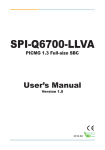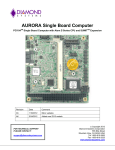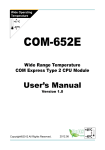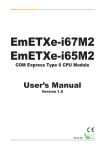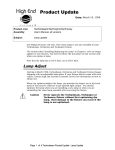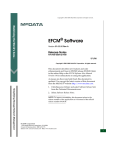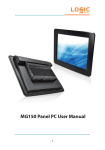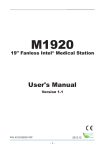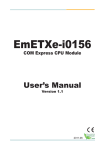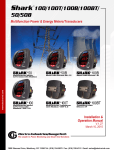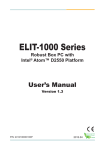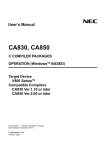Download User`s Manual - Logic Supply
Transcript
KR960 Mini-ITX Industrial Motherboard User’s Manual Version 1.0 2012.10 Index Table of Contents Chapter 1 - Introduction ............................................................................... 1 1.1 Copyright Notice ......................................................................... 2 1.2 Declaration of Conformity .......................................................... 2 1.3 About This User’s Manual .......................................................... 4 1.4 Warning ........................................................................................ 4 1.5 Replacing the Lithium Battery ................................................... 4 1.6 Technical Support ....................................................................... 5 1.7 Warranty ....................................................................................... 5 1.8 Packing List ................................................................................. 6 1.9 Ordering Information .................................................................. 6 1.10 Recommended CPU List........................................................... 6 ............................................................................ 7 1.12 Installing the CPU...................................................................... 8 1.13 Board Dimensions..................................................................... 9 1.14 Installing the Memory ............................................................. 10 Chapter 2 - Installation ............................................................................... 11 2.1 Block Diagram ........................................................................... 12 2.2 Jumpers and Connectors ......................................................... 13 Jumpers ............................................................................................ 14 JPWR1: AT/ATX Power Mode Selection ...........................................14 JBAT1: Clear CMOS Setting..............................................................14 JRS1: COM2 RS-232 / 422 / 485 Selection .......................................14 CON1: COM3/4 Power Source Select on Pin 9................................15 JME1: ME Function Select ...............................................................15 Connectors ....................................................................................... 15 JSPI1: SPI Flash for External SPI Programming Tools ..................15 USB2: USB Port Connector ..............................................................15 INV1: LCD Inverter Connector ..........................................................16 COM1: RS-232 Connector .................................................................16 LVDS1: LVDS Connector ...................................................................16 AUDIO1: Audio Interface Port ...........................................................17 LAN1, 2: Ethernet Connectors (include USB0/1/2/3 Connector) ...17 USB1: 4 x USB Port Connector ........................................................18 DVI1: DVI-I Connector .......................................................................19 KBUSB1: PS/2 Keyboard and USB x 2 ............................................19 COM2: Serial Port Connector ...........................................................20 COM3~6: Serial Port Connectors .....................................................20 DIO1: DIO Port ....................................................................................20 12VIN1: ATX12V Connector ..............................................................21 -i- Index FAN1, 2: Fan Connectors ..................................................................21 JFRT1: Switches and Indicators ......................................................21 PWROUT1: SATA Power Connector .................................................21 SATA1~6: Serial ATA Connectors .....................................................22 LPC1: Low Pin Count Connector .....................................................22 MC1: Mini-card Slot ...........................................................................22 2.3 The Installation Paths of CD Driver ......................................... 24 Chapter 3 - BIOS ......................................................................................... 25 3.1 Main ............................................................................................ 26 3.2 Advanced ................................................................................... 28 3.2.1 ACPI Settings ...........................................................................29 3.2.2 S5 RTC Wake Settings.............................................................30 ...................................................................31 .................................................................33 3.2.5 Intel(R) Rapid Start Technology .............................................36 .......................37 ...................................................................38 ...................................................................39 3.2.9 SMART Settings .......................................................................41 ...........................................42 .........................................................43 3.2.12 H/W Monitor ............................................................................45 3.2.13 Intel(R) Smart Connect Technology .....................................46 ........................................................47 3.3 Chipset ....................................................................................... 48 ..............................................................49 ..........................................54 3.4 Boot ............................................................................................ 61 3.4.1 CSM parameters ......................................................................62 3.5 Security ...................................................................................... 64 3.6 Save & Exit Options .................................................................. 65 3.7 AMI BIOS Checkpoints ............................................................. 66 3.7.1 Checkpoint Ranges .................................................................66 3.7.2 Standard Checkpoints .............................................................67 Appendix ..................................................................................................... 75 Appendix A: I/O Port Address Map ................................................ 76 Appendix B: BIOS Memory Map .................................................... 79 Appendix C: Interrupt Request Lines (IRQ) .................................. 81 Appendix D: Digital I/O Setting ...................................................... 82 Appendix E: Watchdog Timer (WDT) Setting................................ 91 - ii - Introduction 1 Chapter 1 Introduction Chapter 1 - Introduction -1- Introduction 1.1 Copyright Notice All Rights Reserved. The information in this document is subject to change without prior notice in order to improve the reliability, design and function. It does not represent a commitment on the part of the manufacturer. Under no circumstances will the manufacturer be liable for any direct, indirect, special, incidental, or consequential damages arising from the use or inability to use the product or documentation, even if advised of the possibility of such damages. This document contains proprietary information protected by copyright. All rights are reserved. No part of this manual may be reproduced by any mechanical, electronic, or other means in any form without prior written permission of the manufacturer. 1.2 Declaration of Conformity CE The CE symbol on your product indicates that it is in compliance with the by contacting Technical Support. shielded cables are used for external wiring. We recommend the use of shielded cables. This kind of cable is available from Logic Supply. Please contact your local supplier for ordering information. conditions for passing included the equipment being operated within an industrial enclosure. In order to protect the product from being damaged by ESD (Electrostatic Discharge) and EMI leakage, we strongly recommend the use of CE-compliant industrial enclosure products. -2- Introduction FCC Class B This device complies with Part 15 of the FCC Rules. Operation is subject to the following two conditions: (1)This device may not cause harmful interference, and (2)This device must accept any interference received, including interference that may cause undesired operation. NOTE: This equipment has been tested and found to comply with the limits for a Class B digital device, pursuant to Part 15 of the FCC Rules. These limits are designed to provide reasonable protection against harmful interference in a residential installation. This equipment generates, uses and can radiate radio frequency energy and, if not installed and used in accordance with the instructions, may cause harmful interference to radio communications. However, there is no guarantee that interference will not occur in a particular installation. If this equipment does cause harmful interference to radio or television reception, which can be determined by turning the equipment off and on, the user is encouraged to try to correct the interference by one or more of the following measures: -- Reorient or relocate the receiving antenna. -- Increase the separation between the equipment and receiver. -- Connect the equipment into an outlet on a circuit different from that to which the receiver is connected. -- Consult the dealer or an experienced radio/TV technician for help. RoHS LGX Systems, certifies that all components in its products are in compliance and conform to the European Union’s Restriction of Use of Hazardous Substances in Electrical and Electronic Equipment (RoHS) Directive 2002/95/EC. The above mentioned directive was published on 2/13/2003. The main purpose of the directive is to prohibit the use of lead, mercury, cadmium, hexavalent chromium, polybrominated biphenyls (PBB), and polybrominated diphenyl ethers (PBDE) in electrical and electronic products. Member states of the EU are to enforce by 7/1/2006. LGX Systems hereby states that the listed products do not contain -3- Introduction unintentional additions of lead, mercury, hex chrome, PBB or PBDB that exceed a maximum concentration value of 0.1% by weight or for cadmium exceed as a substance or mixture of substances with uniform composition (such as solders, resins, plating, etc.). Lead-free solder is used for all terminations (Sn(9696.5%), Ag(3.0-3.5%) and Cu(0.5%)). SVHC / REACH To minimize the environmental impact and take more responsibility to the of SVHC (Substances of Very High Concern) in (EC) 1907/2006 (REACH --Registration, Evaluation, Authorization, and Restriction of Chemicals) regulated by the European Union. All substances listed in SVHC < 0.1 % by weight (1000 ppm) 1.3 About This User’s Manual This user’s manual provides general information and installation instructions about the product. This User’s Manual is intended for experienced users and integrators with hardware knowledge of personal computers. If you are not sure about any description in this booklet. please consult your vendor before further handling. 1.4 Warning Single Board Computers and their components contain very delicate Integrated Circuits (IC). To protect the Single Board Computer and its components against damage from static electricity, you should always follow the following precautions when handling it : 1. Disconnect your Single Board Computer from the power source when you want to work on the inside. 2. Hold the board by the edges and try not to touch the IC chips, leads or circuitry. 3. Use a grounded wrist strap when handling computer components. 4. Place components on a grounded antistatic pad or on the bag that comes with the Single Board Computer, whenever components are separated from the system. 1.5 Replacing the Lithium Battery Incorrect replacement of the lithium battery may lead to a risk of explosion. -4- Introduction The lithium battery must be replaced with an identical battery or a battery type recommended by the manufacturer. Do not throw lithium batteries into the trash-can. It must be disposed of in accordance with local regulations concerning special waste. 1.6 Technical Support customer service. Phone: +1 802 861 7474 E-mail: [email protected] 1.7 Warranty This product is warranted to be in good working order for a period of two years from the date of purchase. Should this product fail to be in good working order at any time during this period, we will, at our option, replace or repair it at no additional charge except as set forth in the following terms. This warranty does other incidental or consequential damage resulting from the use, misuse of, or inability to use this product. Vendor will not be liable for any claim made by any other related party. Vendors disclaim all other warranties, either expressed or implied, including particular purpose, with respect to the hardware, the accompanying product’s manual(s) and written materials, and any accompanying hardware. This limited Return authorization must be obtained from the vendor before returned merchandise will be accepted. Authorization can be obtained by calling or faxing the vendor and requesting a Return Merchandise Authorization (RMA) number. Returned goods should always be accompanied by a clear problem description. -5- Introduction 1.8 Packing List Before you begin installing your single board, please make sure that the following materials have been shipped: 1 x KR960 Mini-ITX industrial motherboard 1 x Driver CD 1 x Quick Installation Guide 1 x I/O Bracket If any of the above items are damaged or missing, contact your vendor immediately. 1.9 Ordering Information KR960 Intel® Ivy Bridge rPGA988 socket Core™ i7/i5/i3, Celeron® embedded Mini-ITX motherboard CBK-KR960 Cable kit 2 x Two ports COM cables 1 x COM Flat cable 1.10 Recommended CPU List Intel® 3rd Generation i7-3610QE 2.3GHz Core™ Processor i5-3610ME 2.7GHz Core™ Processor i3-3120ME 2.4GHz Core™ Processor Intel® 2nd Generation i7-2710QE 2.1GHz Core™ Processor i5-2510E 2.5GHz Core™ Processor i3-2330E 2.2GHz Core™ Processor B810 1.6GHz Celeron® Processor -6- 1 x USB cable 2 x SATA cables 1 x SATA Power cable Introduction System CPU Support 3rd Generation Intel® Core™ i7/i5/i3 processors in rPGA988 (Socket G2) Memory 2 x 204-pin DDR3 DIMM Sockets, supporting 1333/1600MHz SDRAM up to 16GB Chipset Intel® QM77 BIOS AMI BIOS Watchdog Timer 1~255 levels reset I/O I/O Chip Fintek F71869ED + Fintek F81216AD 5 x RS-232 ports Serial Port control USB Port 4 x USB 3.0/2.0 compatible ports 8 x USB 2.0 ports KB/MS 1 x 6-pin wafer connector for PS/2 keyboard and mouse Digital I/O 1 x 16-bit programmable Digital Input/Output Expansion Bus Storage Ethernet Chipset Audio Interface 1 x PCIe x16 slot 1 x Mini-card slot 2 x Serial ATA ports with 600MB/s HDD transfer rate 4 x Serial ATA ports with 300MB/s HDD transfer rate 1 x Intel® 82579LM PCIe GbE PHY w/ iAMT 1 x Intel® 82583V PCIe GbE controller Realtek ALC886 HD Audio Codec, Mic-in/Line-in/ Line-out Display Graphics Chipset Integrated Intel HD Graphics 2500 or HD Graphics 4000 -7- Introduction Graphics Interface 1 x DVI-I connector, supporting either Analog RGB or DVI, resolution up to 2048 x 1536 for Analog RGB and 1920 x 1200 for TMDS Support Dual Channel 24-bit LVDS up to 1600 x 1200 resolution Mechanical & Environmental Power Requirement DC12V input only Power Consumption 4.3A@+12V with i7-3610QE (Typical) Operating Temp. -20 ~ 70°C (-4 ~ 158°F) Operating Humidity 0 ~ 95% (non-condensing) Dimensions (L x W) 170 x 170 mm (6.7" x 6.7") 1.12 Installing the CPU The processor socket comes with a screw to secure the CPU. As shown in the Place the CPU into the socket by making sure the notch on the corner of the CPU correspond to the notch on the inside of the socket. Once the CPU slides into the socket, lock the screw. Make sure that heatsink is in complete contact with top surface of the CPU to avoid the CPU’s overheating problem. If not, it would cause your system or CPU to be hanged, unstable, damaged. -8- Introduction 1.13 Board Dimensions Unit: mm -9- Introduction 1.14 Installing the Memory To install the memory module: 1. Find the memory DIMM socket on the board. The DIMM socket has a slot connector with a off-center break and two place. 2. Position the memory module’s pin side at the SO-DIMM socket, with the memory module’s key notch aligning at the SO-DIMM socket’s slot connector break. Lock Lock 3. Insert the memory module to the slot connector at an slanted angle. Note to “fully” insert the memory module to avoid improper insertion. 4. Press down the memory module until it auto-clicks in place. To uninstall the memory module: 1. Pull back the latches from both sides of the SO-DIMM socket. The memory module will be auto-released from the socket. 2. Remove the memory module. - 10 - Installation 2 Chapter 2 Installation Chapter 2 - Installation - 11 - Installation 2.1 Block Diagram Channel A DDR3 1333/1600 Ivy Bridge rPGA988B(non-ECC) PCI-E x 16 SLOT Channel B PCI-E x 16 DMI2 (x4) FDI CH7318 DVI-I connector DVI + CRT DDI Port C R, G, B output Internal LVDS(18bit/24bit support) DDR3 1333/1600 SATA 3.0 x2 / SATA 2.0 x4 Intel Management Engine LVDS PCI-E x1 2.5 GT/s SPI SPI Flash USB 2.0 USB 2.0 (x12) Intel 82579LM GbE PHY LPC Super I/O F71869ED LAN1 (RJ-45 connector) Mobile Intel QM77 Chipset PS/2 x 1 (Y-Cable use) PCI-E x1 2.5 GT/s Intel 82583V GbE Controller FAN1, FAN2 (smart fan control) LAN2 (RJ-45 connector) COM5 , COM6 2.5 GT/s PCI-E MINI CARD LPC1 debug port ALC886 HD Audio UART-F81216AD Mic-in/Line-in/Line-out COM1 RS232 w/ DB9 conn. COM 2 RS232/422/485, COM3, COM4 RS232 16-bit Digital I/O connector SMBus F75111RG - 12 - Installation 2.2 Jumpers and Connectors 27 24 FAN1 JFRT1 25 FAN2 35 PWROUT1 26 SATA2 SATA1 SATA4 28 SATA3 29 31 30 23 12VIN1 22 COM6 21 COM5 20 DIO1 19 CON1 COM4 COM2 COM3 18 SATA6 SATA5 32 JME1 1 JPWR1 2 JSPI1 3 JBAT1 4 USB2 6 LVDS1 MC1 33 17 16 15 5 34 JRS1 14 KBUSB1 13 12 11 DVI1 COM1 10 USB1 - 13 - 9 LAN1 8 LAN2 7 AUDIO1 INV1 LPC1 Installation Jumpers Jumper Settings The jumper is “short” (closed) when the jumper cap is placed on pins. If not, that means the jumper is “open.” Pin open Pin short (closed) Pin 2-3 short (closed) Pin 1-2 short (closed) JPWR1: AT/ATX Power Mode Selection (1) Connector type: 2.00mm pitch 1x3-pin header. Pin Power Mode Selection 1-2 ATX Mode (Default) 2-3 AT Mode 3 2 1 3 2 1 JBAT1: Clear CMOS Setting (3) Connector type: 2.00mm pitch 1x3-pin header. Pin Mode 1-2 Keep CMOS data (Default) 2-3 Clear CMOS data 3 2 1 3 2 1 JRS1: COM2 RS-232 / 422 / 485 Selection (14) Connector type: 2.00mm pitch 2x4-pin header. Assignment Pin RS-232 (Default) RS-422 RS-485 1-2 Short Open Open 3-4 Open Short Open 5-6 Open Open Short 7-8 ** Short Short Open/Short ** 485 Auto-Flow selection, Open: Enable, Short: Disable. - 14 - 1 2 7 8 Installation CON1: COM3/4 Power Source Select on Pin 9 (18) Connector type: 2.00mm pitch 2x5-pin header. Default setting: Standard Pin 9 Power Source Special Support COM3 CON1 COM4 CON1 Standard (RI) (Default) 7-9 8-10 POS: 12V/1A on Pin 9 1-3 2-4 POS: 5V/1A on Pin 9 3-5 4-6 1 2 9 10 JME1: ME Function Select (32) Connector type: 2.00mm pitch 1x3-pin header. Pin Power Mode Selection 1-2 ME Enable/ME Flash disable (Default) 2-3 ME Disable/ME Flash enable 3 2 1 3 2 1 Connectors JSPI1: SPI Flash for External SPI Programming Tools (2) Connector type: 2.54mm pitch 2x4-pin header. Pin Desc. Pin Desc. 1 2 1 V_3P3_SPI 2 GND 3 SPI_CS0_R 4 SPI_CLK_R 5 SPI_SO_R 6 SPI_SI_R 7 NC 8 NC 7 8 USB2: USB Port Connector (4) Connector type: 2.54mm pitch 2x5-pin header. Pin Description Pin Description 1 2 1 +5V 2 +5V 3 USBD2- 4 USBD3- 5 USBD2+ 6 USBD3+ 7 GND 8 GND 9 GND 10 N/C (Key) 9 10 - 15 - Installation INV1: LCD Inverter Connector (5) Connector type: 2.00mm pitch 1x5 box wafer connector. Pin Description 1 +12V 2 GND 3 Backlight on/off 4 Brightness control 5 GND 1 2 3 4 5 COM1: RS-232 Connector (11) Connector type: D-sub 9-pin male connector. Pin Desc. Pin Desc. 1 DCD 6 DSR 2 RX 7 RTS 3 TX 8 CTS 4 DTR 9 RI 5 GND 10 NC 1 6 5 9 LVDS1: LVDS Connector (6) Connector type: DF-13-34DP-1.25V connector. Pin Description Pin Description 2 VDD 1 VDD 4 TX2CLK+ 3 TX1CLK+ 6 TX2CLK- 5 TX1CLK- 8 GND 7 GND 10 TX2D0+ 9 TX1D0+ 12 TX2D0- 11 TX1D0- 14 GND 13 GND 16 TX2D1+ 15 TX1D1+ - 16 - 2 1 30 29 Installation 18 TX2D1- 17 TX1D1- 20 GND 19 GND 22 TX2D2+ 21 TX1D2+ 24 TX2D2- 23 TX1D2- 26 GND 25 GND 28 TX2D3+ 27 TX1D3+ 30 TX2D3- 29 TX1D3- AUDIO1: Audio Interface Port (7) Connector type: triple stacked audio jacks (Stereo ø3.50). Blue: Line In Green: Line Out Pink: MIC In LAN1, 2: Ethernet Connectors (include USB0/1/2/3 Connector) (9, 8) Connector type: RJ-45 + double stacked USB type A connector. LAN (RJ-45) Pin Description 1 MDI0+ 2 MDI0- 3 MDI1+ LED 4 MDI1- 5 MDI2+ 6 MDI2- 7 MDI3+ 8 MDI3- LED LAN 87654321 - 17 - 1 2 3 4 USB 1 2 3 4 USB Installation USB (USB type A connector) Pin Description 1 +5V 2 USB- 3 USB+ 4 GND USB1: 4 x USB Port Connector (10) Connector type: 4-stack USB 3.0/2.0 type A connector. Pin Desc. Pin Desc. 11 5V 21 5V 12 USBD122 USBD213 USBD1+ 23 USBD2+ 14 GND1 24 GND3 15 SSRX125 SSRX216 SSRX1+ 26 SSRX2+ 17 GND2 27 GND4 18 SSTX128 SSTX219 SSTX1+ 29 SSTX2+ 31 5V 41 5V 32 USBD342 USBD433 USBD3+ 43 USBD4+ 34 GND5 44 GND7 35 SSRX345 SSRX436 SSRX3+ 46 SSRX4+ 37 GND6 47 GND8 38 SSTX348 SSTX439 SSTX3+ 49 SSTX4+ H1 GND H4 GND H2 GND H5 GND H3 GND H6 GND - 18 - Installation DVI1: DVI-I Connector (12) 1 8 C1 C2 9 16 C5 17 24 C3 C4 Pin Description Pin Description Pin Description 1 TX2- 13 N.C. C1 Analog RED 2 TX2+ 14 +5V/50mA C2 Analog Green 3 TX2/4GND 15 GND C3 Analog Blue 4 N.C. 16 HTPLG C4 Analog V_SYNC 5 N.C. 17 TX0- C5 Analog R, G, B Return 6 DDC_CLK 18 TX0+ 7 DDC_DATA 19 TX0/5GND 8 CRT_Vsync 20 N.C. 9 TX1- 21 N.C. 10 TX1+ 22 TXC_GND 11 TX1/3GND 23 TXC+ 12 N.C. 24 TXC- KBUSB1: PS/2 Keyboard and USB x 2 (13) Connector type: PS/2 Keyboard + USB connector. Keyboard (Purple) MS_CLK KB_VCC MS_DAT KB_CLK KB_GND KB_DAT - 19 - Installation COM2: Serial Port Connector (16) Connector type: 2.00mm pitch 2x7-pin box header. Pin Desc. Pin Desc. 1 DCD2 2 RXD2 3 TXD2 4 DTR2 5 GND 6 DSR2 7 RTS2 8 CTS2 9 RI2 10 NC 11 422TX+_485+ 12 422TX-_485- 13 422RX+ 14 422RX- 1 2 1314 COM3~6: Serial Port Connectors (15, 17, 20, 21) Connector type: 2.00mm pitch 2x5-pin box header. Pin Desc. Pin Desc. 1 DCD1 2 RXD1 3 TXD1 4 DTR1 5 GND 6 DSR1 7 RTS1 8 CTS1 9 RI1 10 NC 1 2 9 10 DIO1: DIO Port (19) Connector type: 2.00mm pitch 2x10-pin header. Pin Desc. Pin Desc. 1 DIO0 2 DIO1 3 DIO2 4 DIO3 5 DIO4 6 DIO5 7 DIO6 8 DIO7 9 DIO8 10 DIO9 11 DIO10 12 DIO11 13 DIO12 14 DIO13 15 DIO14 16 DIO15 17 5V 18 GND 19 5V 20 GND 1 2 23 24 - 20 - Installation 12VIN1: ATX12V Connector (22) 12INV1 supplies the CPU operation ATX +12V (Vcore). Pin Description Pin Description 2 GND 1 GND 4 +12V 3 +12V 2 1 4 3 FAN1, 2: Fan Connectors (23, 25) Connector type: 2.54mm pitch 1x4-pin wafer connector. Pin Description 1 1 GND 2 2 +12V 3 4 3 FAN_Detect 4 Control JFRT1: Switches and Indicators (24) It provides connectors for system indicators that provide light indication of the computer activities and switches to change the computer status. Connector type: 2.54mm pitch 2x5-pin header. Pin Description Pin Description 1 RESET+ 2 RESET- 3 POWER_LED+ 4 POWER_LED- 5 HDD_LED+ 6 HDD_LED- 7 SPEAKER+ 8 SPEAKER- 9 PSON+ 10 PSON- PWROUT1: SATA Power Connector (35) Connector type: 2.50mm pitch 1x4-pin wafer connector. Pin Description 1 1 5V 2 2 GND 3 4 3 GND 4 12V_FAN2 - 21 - 1 9 2 10 Installation SATA1~6: Serial ATA Connectors (26~31) High speed transfer rates (150MB/s). Pin Description 1 GND 2 TX+ 3 TX- 4 GND 5 RX- 6 RX+ 7 GND 1 7 LPC1: Low Pin Count Connector (34) Connector type: CVILUX 0.5mm CF20141U0*0-LF connector. Pin Desc. Pin Desc. 1 LPC_D0 8 LPC_RST# 2 LPC_D1 9 GND 3 LPC_D2 10 LPC_CLK_33Mhz 4 LPC_D3 11 GND 5 GND 12 GND 6 LPC_FRAME# 13 +3.3V 7 SERIRQ 14 +3.3V 14 MC1: Mini-card Slot (33) 2 1 15 17 51 1 16 18 52 - 22 - Installation Pin 1 3 5 7 9 11 13 15 17 19 21 23 25 27 29 31 33 35 37 39 41 43 45 47 49 51 Desc. Wake COEX1 COEX2 CLKREQ# GND REFCLKREFCLK+ GND UIM_C8/Reserved UIM_C4/Reserved GND PERn0 PERp0 GND GND PETn0 PETp0 GND GND +3.3V +3.3V GND Reserved Reserved Reserved Reserved Pin 2 4 6 8 10 12 14 16 18 20 22 24 26 28 30 32 34 36 38 40 42 44 46 48 50 52 Desc. +3.3V GND +1.5V UIM_PWR UIM_DATA UIM_CLK UIM_RESET UIM_VPP GND W_Disable# PERST# +3.3V GND +1.5V SMB_CLK SMB_DATA GND USB_DUSB_D+ GND LED_WWAN# LED_WLAN# LED_WPAN# +1.5V GND +3.3V - 23 - Installation 2.3 The Installation Paths of CD Driver Windows 7 Driver Path CHIPSET \KR960\CHIPSET\Win7 ME \KR960\ME\MEI_allOS_8.0.4.1441_PV_5M GRAPHICS \KR960\GRAPHICS\Win7\Win32 \KR960\GRAPHICS\Win7\Win64 LAN \KR960\ETHERNET\WIN_allos_Ver16.3 AUDIO \KR960\AUDIO\Vista_Win7_R261-32_64 bit USB3.0 \KR960\USB3.0 - 24 - BIOS 3 Chapter 3 BIOS Chapter 3 - BIOS - 25 - BIOS 3.1 Main The AMI BIOS provides a Setup utility program for specifying the system immediately activated. To enter the BIOS SETUP UTILITY, press “Delete” once the power is turned on. When the computer is shut down, the battery on the motherboard supplies the power for BIOS RAM. The Main Setup screen lists the following information: Aptio Setup Utility - Copyright (C) 2011 American Megatrends, Inc. Main Advanced Chipset Boot Security Save & Exit BIOS Information BIOS Vendor Core Version Compliancy Project version Build Date and Time American Megatrends 4.6.5.3 UEFI 2.3; PI 1.2 KR960 0.0.1 X64 06/28/2012 12:38:26 System Language [English] System Date System Time [Wed 10/03/2012] [17:31:42] Access Level Administrator Choose the system default language ȲȰ6HOHFW6FUHHQ ȳȱ6HOHFW,WHP Enter: Select +/-: Change Opt. F1: General Help F2: Previous Values F9: Optimized Defaults F10: Save and Exit ESC: Exit Version 2.14.1219. Copyright (c) 2011 American Megatrendes, Inc. Setting Description BIOS Information BIOS Vendor displays vendor name Core Version displays current core version information Compliancy displays compliant format Project Version displays current BIOS version information Build Date and Time the date that the BIOS version was made/updated - 26 - BIOS System Language Choose the system default language System Date Set the system date. Note that the ‘Day’ automatically changes when you set the date. Ź The date format is: Day: Sun to Sat Month: 1 to 12 Date: 1 to 31 Year: 1998 to 2099 System Time Set the system time. Ź The time format is: Hour: 00 to 23 Minute: 00 to 59 Second: 00 to 59 Key Commands BIOS Setup Utility is mainly a key-based navigation interface. Please refer to the following key command instructions for navigation process. Keystroke ŻŹ źŸ Function the top menu bar / Move to highlight items on the screen Move to highlight previous/next item Enter Esc On the Main Menu – Quit the setup and not save changes into CMOS (a message screen will display and ask you to select “OK” or “Cancel” for exiting and GLVFDUGLQJFKDQJHV8VH³ĸ´DQG³ĺ´WRVHOHFWDQGSUHVV On the Sub Menu – Exit current page and return to main menu Page Up / + Increase the numeric value on a selected setup item / make change Page Down - Decrease the numeric value on a selected setup item / make change F1 F10 Activate “General Help” screen Save the changes that have been made in the setup and exit. (a message screen will display and ask you to select ³2.´RU³&DQFHO´IRUH[LWLQJDQGVDYLQJFKDQJHV8VH³ĸ´ - 27 - BIOS 3.2 Advanced of your hardware, such as ACPI, CPU, SATA, AMT, USB and (Second) Super IO. Aptio Setup Utility - Copyright (C) 2011 American Megatrends, Inc. Main $GYDQFHG Chipset Boot Security 6DYH([LW ɱ ɱ ɱ ɱ ɱ ɱ ɱ ɱ ɱ ɱ ɱ ɱ ɱ ɱ ACPI Settings S5 RTC Wake Settings CPU Configuration SATA Configuration Intel(R) Rapid Start Technology Intel(R) Anti-Theft Technology Configuration AMT Configuration USB Configuration SMART Settings Second Super IO Configuration Super IO Configuration H/W Monitor Intel(R) Smart Connect Technology CPU PPM Configuration System ACPI Parameters ȲȰ6HOHFW6FUHHQ ȳȱ6HOHFW,WHP (QWHU6HOHFW &KDQJH2SW )*HQHUDO+HOS )3UHYLRXV9DOXHV )2SWLPL]HG'HIDXOWV )6DYHDQG([LW (6&([LW Version 2.14.1219. Copyright (c) 2011 American Megatrendes, Inc. Setting Description ACPI Settings See Section 3.2.1 S5 RTC Wake Settings See Section 3.2.2 See Section 3.2.3 See Section 3.2.4 Intel(R) Rapid Start Technology See Section 3.2.5 See Section 3.2.6 See Section 3.2.7 See Section 3.2.8 SMART Settings See Section 3.2.9 - 28 - BIOS See Section 3.2.10 See Section 3.2.11 H/W Monitor See Section 3.2.12 Intel(R) Smart Connect Technology See Section 3.2.13 See Section 3.2.14 3.2.1 ACPI Settings Aptio Setup Utility - Copyright (C) 2011 American Megatrends, Inc. Advanced ACPI Settings Enable Hibernation ACPI Sleep State Power-Supply Type Enables or Disables System ability to Hibernate (OS/S4 Sleep State). This option [Enabled] [Both S1 and S3 ava...] may be not effective with some OS. [ATX] ȲȰ6HOHFW6FUHHQ ȳȱ6HOHFW,WHP (QWHU6HOHFW &KDQJH2SW )*HQHUDO+HOS )3UHYLRXV9DOXHV )2SWLPL]HG'HIDXOWV )6DYHDQG([LW (6&([LW Version 2.14.1219. Copyright (c) 2011 American Megatrendes, Inc. Setting Enable Hibernation Description Enable (default) or Disable system ability to Hibernate (OS/S4 Sleep State). This option may be not effective with some OS. - 29 - BIOS ACPI Sleep State Select ACPI sleep state the system will enter when the SUSPEND button is pressed. Ź Options: Suspend Disabled, S1 only(CPU Stop Clock), S3 only(Suspend to RAM), Both S1 and S3 available for OS to choose from (default). Power-Supply Type Select Power-Supply Type. Ź Options: AT, ATX (default). 3.2.2 S5 RTC Wake Settings Enable system to wake from S5 using RTC alarm. Aptio Setup Utility - Copyright (C) 2011 American Megatrends, Inc. Advanced Wake system with Fixed Time [Disabled] Wake system with Dynamic Time [Disabled] Enable or disable System wake on alarm event. When enabled, System will wake on the hr::min::sec specified ȲȰ6HOHFW6FUHHQ ȳȱ6HOHFW,WHP Enter: Select +/-: Change Opt. F1: General Help F2: Previous Values F9: Optimized Defaults F10: Save and Exit ESC: Exit Version 2.14.1219. Copyright (c) 2011 American Megatrendes, Inc. Setting Wake system with Fixed Time Description Enable or Disable (default) System wake on alarm event. When enabled, System will wake on the - 30 - BIOS Wake system with Dynamic Time Enable or Disable (default) System wake on alarm event. When enabled, System will wake on the current time + Increase minute(s). Aptio Setup Utility - Copyright (C) 2011 American Megatrends, Inc. Advanced CPU Configuration Intel(R) Core(TM) i7-3610QE CPU @ 2.30GHz 306a8 CPU Signature 10 Microcode Patch 2300 MHz Max CPU Speed 1200 MHz Min CPU Speed 2300 MHz CPU Speed 4 Processor Cores Supported Intel HT Technology Supported Intel VT-x Technology Supported Intel SMX Technology Supported 64-bit L1 L1 L2 L3 Data Cache Code Cache Cache Cache Hyper-threading Active Processor Cores Limit CPUID Maximum Execute Disable Bit Intel Virtualization Technology Hardware Prefetcher Adjacent Cache Line Prefetch 32 KB x 4 32 KB x 4 256 KB x 4 6144 KB To turn on/off prefetching of adjacent cache lines. ȲȰ6HOHFW6FUHHQ ȳȱ6HOHFW,WHP (QWHU6HOHFW &KDQJH2SW )*HQHUDO+HOS )3UHYLRXV9DOXHV )2SWLPL]HG'HIDXOWV )6DYHDQG([LW (6&([LW [Enabled] [All] [Disabled] [Enabled] [Disabled] [Enabled] [Enabled] Version 2.14.1219. Copyright (c) 2011 American Megatrendes, Inc. - 31 - BIOS Setting Description Hyper-threading Enabled (default) for Windows XP and Linux (OS optimized for Hyper-threading Technology) and Disabled for other OS (OS not optimized for Hyper-threading Technology). When Disabled, only one thread per enabled core is enabled. Active Processor Cores Number of cores to enable in each processor package. Ź Options: All (default), 1, 2, 3 Limit CPUID Maximum Disabled for Windows XP Ź Options: Enabled and Disabled (default). Execute Disable Bit XP can prevent certain classes of malicious buffer ing OS (Windows Server 2003 SP1, Windows XP SP2, SuSE Linux 9.2, RedHat Enterprise 3 Update 3.) Ź Options: Enabled (default) and Disabled. Intel Virtualization Technology When enabled, a VMM can utilize the additional hardware capabilities provided by Vanderpool Technology. Ź Options: Enabled and Disabled (default). Hardware Prefetcher To turn on/off the Mid Level Cache (L2) streamer prefetcher. Ź Options: Enabled (default) and Disabled. Adjacent Cache Line Prefetch To turn on/off prefetching of adjacent cache lines. Ź Options: Enabled (default) and Disabled. - 32 - BIOS Aptio Setup Utility - Copyright (C) 2011 American Megatrends, Inc. $GYDQFHG [Enabled] SATA Controller(s) >$+&,@ SATA Mode Selection >*HQ@ SATA Controller Speed ɱ6RIWZDUH)HDWXUH0DVN&RQILJXUDWLRQ 6HULDO$7$3RUW 6RIWZDUH3UHVHUYH 3RUW +RW3OXJ ([WHUQDO6$7$ 6$7$'HYLFH7\SH 6SLQ8S'HYLFH 6HULDO$7$3RUW 6RIWZDUH3UHVHUYH 3RUW +RW3OXJ ([WHUQDO6$7$ 6$7$'HYLFH7\SH 6SLQ8S'HYLFH 6HULDO$7$3RUW 6RIWZDUH3UHVHUYH 3RUW +RW3OXJ ([WHUQDO6$7$ 6$7$'HYLFH7\SH 6SLQ8S'HYLFH 6HULDO$7$3RUW 6RIWZDUH3UHVHUYH 3RUW +RW3OXJ ([WHUQDO6$7$ 6$7$'HYLFH7\SH 6SLQ8S'HYLFH 6HULDO$7$3RUW 6RIWZDUH3UHVHUYH 3RUW +RW3OXJ ([WHUQDO6$7$ 6$7$'HYLFH7\SH 6SLQ8S'HYLFH 6HULDO$7$3RUW 6RIWZDUH3UHVHUYH 3RUW +RW3OXJ ([WHUQDO6$7$ 6$7$'HYLFH7\SH 6SLQ8S'HYLFH (QDEOHRU'LVDEOH6$7$ 'HYLFH Empty 8QNQRZQ [Enabled] >'LVDEOHG@ >'LVDEOHG@ >+DUG'LVN'ULYHU@ >'LVDEOHG@ Empty 8QNQRZQ [Enabled] >'LVDEOHG@ >'LVDEOHG@ >+DUG'LVN'ULYHU@ >'LVDEOHG@ Empty 8QNQRZQ [Enabled] >'LVDEOHG@ >'LVDEOHG@ >'LVDEOHG@ >'LVDEOHG@ Empty 8QNQRZQ [Enabled] >'LVDEOHG@ >'LVDEOHG@ >'LVDEOHG@ >'LVDEOHG@ Empty 8QNQRZQ [Enabled] >'LVDEOHG@ >'LVDEOHG@ >'LVDEOHG@ >'LVDEOHG@ Empty 8QNQRZQ [Enabled] >'LVDEOHG@ >'LVDEOHG@ >'LVDEOHG@ >'LVDEOHG@ ȲȰ6HOHFW6FUHHQ ȳȱ6HOHFW,WHP (QWHU6HOHFW &KDQJH2SW )*HQHUDO+HOS )3UHYLRXV9DOXHV )2SWLPL]HG'HIDXOWV )6DYHDQG([LW (6&([LW Version 2.14.1219. Copyright (c) 2011 American Megatrendes, Inc. - 33 - BIOS Setting Description SATA Controller(s) Enable (default) or Disable SATA Device. SATA Mode Selection Determine how SATA controller(s) operate. Ź Options: IDE, AHCI (default) and RAID. SATA Controller Speed Indicates the maximum speed the SATA controller can support. Ź Options: Gen1, Gen2, Gen3 (default) Software Feature Port 0~5 Enable (default) or Disable SATA Port. Hot Plug Designates this port as Hot Pluggable. Ź Options: Enabled and Disabled (default). External SATA External SATA Support. Ź Options: Enabled and Disabled (default). SATA Device Type Identify the SATA port is connected to Solid State Drive or Hard Disk Drive. Ź Options: Hard Disk Driver (default) and Solid State Drive. Spin Up Device On an edge detect from 0 to 1, the PCH starts a COMRESET initialization sequence to the device. Ź Options: Enabled and Disabled (default). - 34 - BIOS Aptio Setup Utility - Copyright (C) 2011 American Megatrends, Inc. $GYDQFHG 5$,' [Enabled] 5$,' [Enabled] 5$,' [Enabled] 5$,' [Enabled] ,QWHO5DSLG5HFRYHU\7HFKQRORJ\ [Enabled] 25208,DQG%$11(5 [Enabled] +''8QORFN [Enabled] [Enabled] /('/RFDWH [Enabled] ,5572QO\RQH6$7$ 6PDUW5HVSRQVH7HFKQRORJ\ [Enabled] 25208,'HOD\ [2 Seconds] Enable or disable 5$,'IHDWXUH ȲȰ6HOHFW6FUHHQ ȳȱ6HOHFW,WHP (QWHU6HOHFW &KDQJH2SW )*HQHUDO+HOS )3UHYLRXV9DOXHV )2SWLPL]HG'HIDXOWV )6DYHDQG([LW (6&([LW Version 2.14.1219. Copyright (c) 2011 American Megatrendes, Inc. Setting Description RAID0/1/10/5 Enable (default) or Disable RAID0/1/10/5 feature. Intel Rapid Recovery Technology Enable (default) or Disable Intel Rapid Recovery Technology. If enabled, then the OROM UI is shown. Otherwise, no OROM banner or information will be disOROM UI and BANNER played if all disks and RAID volumes are Normal. Ź Options: Enabled (default) and Disabled. HDD Unlock If enabled, indicates that the HDD password unlock in the OS is enabled. Ź Options: Enabled (default) and Disabled. - 35 - BIOS LED Locate If enabled, indicates that the LED/SGPIO hardware is attached and ping to locate feature is enabled on the OS. Ź Options: Enabled (default) and Disabled. IRRT Only on eSATA If enabled (default), then only IRRT volumes can span internal and eSATA drives. If disabled, then any RAID volume can span internal and eSATA drives. Smart Response Technology Enable (default) or Disable Smart Response Technology. OROM UI Delay If enabled, indicates the delay of the OROM UI Splash Screen in a normal status. Ź Options: 2 (default) /4/6/8 Seconds 3.2.5 Intel(R) Rapid Start Technology Aptio Setup Utility - Copyright (C) 2011 American Megatrends, Inc. $GYDQFHG Intel(R) Rapid Start Technology >'LVDEOHG@ (QDEOHRUGLVDEOH Intel(R) Rapid Start Technology. ȲȰ6HOHFW6FUHHQ ȳȱ6HOHFW,WHP (QWHU6HOHFW &KDQJH2SW )*HQHUDO+HOS )3UHYLRXV9DOXHV )2SWLPL]HG'HIDXOWV )6DYHDQG([LW (6&([LW Version 2.14.1219. Copyright (c) 2011 American Megatrendes, Inc. - 36 - BIOS Setting Intel(R) Rapid Start Technology Description Enable or Disable (default) Intel(R) Rapid Start Technology. Disabling Intel(R) AT allows User to login to platform. This is strictly for testing only. This does not disable Intel(R) AT Services in ME. Aptio Setup Utility - Copyright (C) 2011 American Megatrends, Inc. $GYDQFHG ,QWHO5$QWL7KHIW7HFKQRORJ\&RQILJXUDWLRQ ,QWHO5$QWL7KHIW7HFKQRORJ\ ,QWHO5$QWL7KHIW7HFKQRORJ\5HF Enter Intel(R) AT Suspend Mode [Enabled] 3 >'LVDEOHG@ (QDEOH'LVDEOH,QWHO 5$7LQ%,26IRU testing only. ȲȰ6HOHFW6FUHHQ ȳȱ6HOHFW,WHP (QWHU6HOHFW &KDQJH2SW )*HQHUDO+HOS )3UHYLRXV9DOXHV )2SWLPL]HG'HIDXOWV )6DYHDQG([LW (6&([LW Version 2.14.1219. Copyright (c) 2011 American Megatrendes, Inc. Setting Description Intel(R) Anti-Theft Technology Enable or Disable (default) Intel(R) AT in BIOS for testing only. Intel(R) Anti-Theft Technology Rec Set the number of times Recovery attempted will be allowed. - 37 - BIOS Aptio Setup Utility - Copyright (C) 2011 American Megatrends, Inc. Advanced [Enabled] Intel AMT Activate Remote Assistance Process [Disabled] 0 AMT CIRA Timeout Enable/Disable Intel (R) Active Management Technology BIOS Extension. Note: iAMT H/W is always enabled. This option just controls the BIOS extension execution.If enabled, this requires additional firmware in the SPI device ȲȰ6HOHFW6FUHHQ ȳȱ6HOHFW,WHP Enter: Select +/-: Change Opt. F1: General Help F2: Previous Values F9: Optimized Defaults F10: Save and Exit ESC: Exit Version 2.14.1219. Copyright (c) 2011 American Megatrendes, Inc. Setting Intel AMT Description Enable (default) or Disable Intel (R) Active Management Technology BIOS Extension. Note: iAMT H/W is always enabled. This option just controls the BIOS extension executhe SPI device Activate Remote Assistance Process Trigger CIRA boot. Ź Options: Enabled and Disabled (default). - 38 - BIOS Aptio Setup Utility - Copyright (C) 2011 American Megatrends, Inc. Advanced USB Configuration USB Devices: 1 Keyboard, 1 Mouse, 2 Hubs Legacy USB Support USB3.0 Support XHCI Hand-off EHCI Hand-off USB Beep Switch [Enabled] [Enabled] [Enabled] [Disabled] [Enabled] USB hardware delays and time-outs: USB transfer time-out [20 sec] Device reset time-out [20 sec] Device power-up delay [Auto] Enables Legacy USB support. AUTO option disables legacy support if no USB devices are connected. DISABLE option will keep USB devices available only for EFI applications. ȲȰ6HOHFW6FUHHQ ȳȱ6HOHFW,WHP Enter: Select +/-: Change Opt. F1: General Help F2: Previous Values F9: Optimized Defaults F10: Save and Exit ESC: Exit Version 2.14.1219. Copyright (c) 2011 American Megatrendes, Inc. Setting Description USB Devices: Legacy USB Support Enables (default) Legacy USB support. AUTO option disables legacy support if no USB devices are connected. DISABLE option will keep USB devices available only for EFI applications. USB3.0 Support Enable (default) or Disable USB3.0 (XHCI) Controller support. XHCI Hand-off This is a workaround for OSes without XHCI handoff support. The XHCI ownership change should be claimed by XHCI driver. Ź Options: Enabled (default) and Disabled. - 39 - BIOS EHCI Hand-off This is a workaround for OSes without EHCI handoff support. The EHCI ownership change should be claimed by EHCI driver. Ź Options: Enabled and Disabled (default). USB Beep Switch Enable (default) or Disable USB Beep sound. USB hardware delays and time-outs: USB transfer time-out The time-out value for Control, Bulk, and Interrupt transfers. Ź Options: 1/5/10/20 sec (default) Device reset time-out USB mass storage device Start Unit command time-out. Ź Options: 10/20 (default)/30/40 sec Maximum time the device will take before it properly reports itself to the host controller. ‘Auto’ uses Device power-up delay default value: for a Root port it is 100ms, for a Hub port the delay is taken from hub descriptor. Ź Options: Auto (default) and Manual - 40 - BIOS 3.2.9 SMART Settings Aptio Setup Utility - Copyright (C) 2011 American Megatrends, Inc. $GYDQFHG SMART Settings 60$576HOI7HVW 5XQ60$576HOI7HVWRQ DOO+''VGXULQJ3267 >'LVDEOHG@ ȲȰ6HOHFW6FUHHQ ȳȱ6HOHFW,WHP (QWHU6HOHFW &KDQJH2SW )*HQHUDO+HOS )3UHYLRXV9DOXHV )2SWLPL]HG'HIDXOWV )6DYHDQG([LW (6&([LW Version 2.14.1219. Copyright (c) 2011 American Megatrendes, Inc. Setting SMART Self Test Description Run SMART Self Test on all HDDs during POST. Ź Options: Enabled and Disabled (default). - 41 - BIOS Aptio Setup Utility - Copyright (C) 2011 American Megatrends, Inc. $GYDQFHG 6HFRQG6XSHU,2&RQILJXUDWLRQ 6XSHU,2&KLS ɱ6HULDO3RUW&RQILJXUDWLRQ ɱ6HULDO3RUW&RQILJXUDWLRQ ɱ6HULDO3RUW&RQILJXUDWLRQ ɱ6HULDO3RUW&RQILJXUDWLRQ 6HW3DUDPHWHUVRI 6HULDO3RUW&20$ Fintek F81216 ȲȰ6HOHFW6FUHHQ ȳȱ6HOHFW,WHP (QWHU6HOHFW &KDQJH2SW )*HQHUDO+HOS )3UHYLRXV9DOXHV )2SWLPL]HG'HIDXOWV )6DYHDQG([LW (6&([LW Version 2.14.1219. Copyright (c) 2011 American Megatrendes, Inc. - 42 - BIOS Aptio Setup Utility - Copyright (C) 2011 American Megatrends, Inc. $GYDQFHG 6HW3DUDPHWHUVRI 6HULDO3RUW 6XSHU,2&RQILJXUDWLRQ 6XSHU,2&KLS ɱ6HULDO3RUW&RQILJXUDWLRQ ɱ6HULDO3RUW&RQILJXUDWLRQ )( 3RZHU2Q$IWHU3RZHU)DLO >3RZHU2II@ ȲȰ6HOHFW6FUHHQ ȳȱ6HOHFW,WHP (QWHU6HOHFW &KDQJH2SW )*HQHUDO+HOS )3UHYLRXV9DOXHV )2SWLPL]HG'HIDXOWV )6DYHDQG([LW (6&([LW Version 2.14.1219. Copyright (c) 2011 American Megatrendes, Inc. Setting Power On After Power Fail Description Specify what state to go to when power is re-applied after a power failure. Ź Options: Power Off (default) and Power On - 43 - BIOS Aptio Setup Utility - Copyright (C) 2011 American Megatrends, Inc. Advanced Enable or Disable Serial Port (COM) Serial Port 1 Configuration Serial Port Device Settings [Enabled] IO=3F8h; IRQ=4; Change Settings [Auto] ȲȰ6HOHFW6FUHHQ ȳȱ6HOHFW,WHP (QWHU6HOHFW &KDQJH2SW )*HQHUDO+HOS )3UHYLRXV9DOXHV )2SWLPL]HG'HIDXOWV )6DYHDQG([LW (6&([LW Version 2.14.1219. Copyright (c) 2011 American Megatrendes, Inc. Setting Description Serial Port Enable (default) or Disable Serial Port (COM) Change Settings Select an optimal setting for Super IO device. - 44 - BIOS 3.2.12 H/W Monitor Aptio Setup Utility - Copyright (C) 2011 American Megatrends, Inc. $GYDQFHG >$XWR)DQE\3:0'XW\@ &38)$10RGHVHWWLQJ &387HPSHUDWXUH/LPLWRI+LJKHVW &387HPSHUDWXUH/LPLWRI/RZHVW 40 &38)DQ+LJKHVW6HWWLQJ 100 &38)DQ6HFRQG6HWWLQJ &38)DQ/RZHVW6HWWLQJ 30 System Fan Mode setting >$XWR)DQE\3:0'XW\@ System 7HPSHUDWXUH/LPLWRI+LJK System 7HPSHUDWXUH/LPLWRI/RZH 40 System Fan +LJKHVW6HWWLQJ 100 System Fan Second Setting System Fan /RZHVW6HWWLQJ 30 3F+HDOWK6WDWXV &387HPSHUDWXUH 6\VWHP7HPSHUDWXUH &38)$16SHHG 6<6)$16SHHG Vcore +5V +1.5V +12V +3.3V 9%$7 °c °c 530 1$ 9 9 9 9 9 9 )$1&RQWURO0RGH setting ȲȰ6HOHFW6FUHHQ ȳȱ6HOHFW,WHP (QWHU6HOHFW &KDQJH2SW )*HQHUDO+HOS )3UHYLRXV9DOXHV )2SWLPL]HG'HIDXOWV )6DYHDQG([LW (6&([LW Version 2.14.1219. Copyright (c) 2011 American Megatrendes, Inc. Setting CPU/System FAN Mode setting Description Fan Control Mode Setting Ź Options: Manual Duty Mode and Auto Fan by PWM Duty (default). CPU/System Temperature Highest Temperature Setting. Limit of Highest Min=0 Max=127 Please input Dec number: CPU/System Temperature Lowest Temperature Setting. Limit of Lowest Min=0 Max=127 Please input Dec number: CPU/System Fan Highest Setting Highest Speed Value Min=0 Max=100 Please input Dec number: - 45 - BIOS CPU/System Fan Second Setting Second Speed Value Min=0 Max=100 Please input Dec number: CPU/System Fan Lowest Setting Lowest Speed Value Min=0 Max=100 Please input Dec number: 3.2.13 Intel(R) Smart Connect Technology Aptio Setup Utility - Copyright (C) 2011 American Megatrends, Inc. $GYDQFHG ,6&7&RQILJXUDWLRQ >'LVDEOHG@ (QDEOH'LVDEOH,6&7 &RQILJXUDWLRQ ȲȰ6HOHFW6FUHHQ ȳȱ6HOHFW,WHP (QWHU6HOHFW &KDQJH2SW )*HQHUDO+HOS )3UHYLRXV9DOXHV )2SWLPL]HG'HIDXOWV )6DYHDQG([LW (6&([LW Version 2.14.1219. Copyright (c) 2011 American Megatrendes, Inc. Setting Description Enable or Disable - 46 - BIOS Aptio Setup Utility - Copyright (C) 2011 American Megatrends, Inc. $GYDQFHG &38330&RQILJXUDWLRQ (QDEOH'LVDEOH,QWHO SpeedStep EIST Turbo Mode &38&5HSRUW &38&5HSRUW &38&5HSRUW &RQILJ7'3/2&. /RQJGXUDWLRQSRZHUOLPLW /RQJGXUDWLRQPDLQWDLQHG 6KRUWGXUDWLRQSRZHUOLPLW $&3,76WDWH [Enabled] [Enabled] [Enabled] [Enabled] [Enabled] >'LVDEOHG@ 0 1 0 >'LVDEOHG@ ȲȰ6HOHFW6FUHHQ ȳȱ6HOHFW,WHP (QWHU6HOHFW &KDQJH2SW )*HQHUDO+HOS )3UHYLRXV9DOXHV )2SWLPL]HG'HIDXOWV )6DYHDQG([LW (6&([LW Version 2.14.1219. Copyright (c) 2011 American Megatrendes, Inc. Setting Description EIST Enable (default) or Disable Intel SpeedStep Turbo Mode Enable (default) or Disable Turbo Mode CPU C3 Report Enable (default) or Disable CPU C3(ACPI C2) report to OS CPU C6 Report Enable (default) or Disable CPU C6(ACPI C3) report to OS CPU C7 Report Enable (default) or Disable CPU C7(ACPI C3) report to OS Ź Long duration power limit Options: Enabled and Disabled (default) Long duration power limit in Watts, 0 means use factory default. - 47 - BIOS Long duration maintained Time window which the long duration power is maintained. Short duration power limit Short duration power limit in watts, 0 means use factory default. ACPI T State Enable or Disable (default) ACPI T state support 3.3 Chipset Aptio Setup Utility - Copyright (C) 2011 American Megatrends, Inc. Main Advanced Chipset Boot Security Save & Exit PCH Parameters ɱ3&+,2&RQILJXUDWLRQ ɱ6\VWHP$JHQW6$&RQILJXUDWLRQ ȲȰ6HOHFW6FUHHQ ȳȱ6HOHFW,WHP (QWHU6HOHFW &KDQJH2SW )*HQHUDO+HOS )3UHYLRXV9DOXHV )2SWLPL]HG'HIDXOWV )6DYHDQG([LW (6&([LW Version 2.14.1219. Copyright (c) 2011 American Megatrendes, Inc. Setting Description See Section 3.3.1 See Section 3.3.2 - 48 - BIOS Aptio Setup Utility - Copyright (C) 2011 American Megatrends, Inc. Chipset ,QWHO3&+5&9HUVLRQ ,QWHO3&+6.81DPH ,QWHO3&+5HY,' 1.2.0.1 QM77 04/C1 PCI Express Configuration settings ɱ 3&+([SUHVV&RQILJXUDWLRQ ɱ USB Configuration 3&+/$1&RQWUROOHU :DNHRQ/$1 [Enabled] [Enabled] +LJK3UHFLVLRQ(YHQW7LPHU&RQILJXUDWLRQ [Enabled] +LJK3UHFLVLRQ7LPHU 6/3B6$VVHUWLRQ:LGWK [4-5 Seconds] ȲȰ6HOHFW6FUHHQ ȳȱ6HOHFW,WHP (QWHU6HOHFW &KDQJH2SW )*HQHUDO+HOS )3UHYLRXV9DOXHV )2SWLPL]HG'HIDXOWV )6DYHDQG([LW (6&([LW Version 2.14.1219. Copyright (c) 2011 American Megatrendes, Inc. Setting Description PCH LAN Controller Enable (default) or Disable onboard NIC. Wake on LAN Enable (default) or Disable integrated LAN to wake the system. (The Wake On LAN cannot be disabled if ME is on at Sx state.) High Precision Timer Enable (default) or Disable the High Precision Event Timer. SLP_S4 Assertion Width Select a minimum assertion width of the SLP_ S4# signal. Ź Options: Disabled (default), 1-2/2-3/34/4-5 Seconds - 49 - BIOS Aptio Setup Utility - Copyright (C) 2011 American Megatrends, Inc. Chipset PCI Express Configuration PCI Express Clock Gating '0,/LQN$630&RQWURO '0,/LQN([WHQGHG6\QFK&RQWURO PCIe-USB Glitch W/A 6XEWUDFWLYH'HFRGH [Enabled] [Enabled] >'LVDEOHG@ >'LVDEOHG@ >'LVDEOHG@ 3&,(3RUWLVDVVLJQHGWR/$1 ɱ PCI Express Root Port 2 ɱ PCI Express Root Port 3 Enable or disable PCI Express Clock Gating for each root port. ȲȰ6HOHFW6FUHHQ ȳȱ6HOHFW,WHP (QWHU6HOHFW &KDQJH2SW )*HQHUDO+HOS )3UHYLRXV9DOXHV )2SWLPL]HG'HIDXOWV )6DYHDQG([LW (6&([LW Version 2.14.1219. Copyright (c) 2011 American Megatrendes, Inc. Setting Description PCI Express Clock Gating Enable (default) or Disable PCI Express Clock Gating for each root port. DMI Link ASPM Control The control of Active State Power Management on both NB side and SB side of the DMI Link. Ź Options: Enabled (default) and Disabled. DMI Link Extended Synch Control The control of Extended Synch on SB side of the DMI Link. Ź Options: Enabled and Disabled (default). PCIe-USB Glitch W/A PCIe-USB Glitch W/A for bad USB devices connected behind PCIE/PEG Port. Ź Options: Enabled and Disabled (default). Subtractive Decode Enable or Disable (default) PCI Express Subtractive Decode. - 50 - BIOS Aptio Setup Utility - Copyright (C) 2011 American Megatrends, Inc. Chipset PCI Express Root Port 2 ASPM Support URR FER NFER CER &72 SEFE SENFE SECE PME SCI +RW3OXJ PCIe Speed ([WUD%XV5HVHUYHG 5HVHUYHG0HPRU\ 3UHIHWFKDEOH0HPRU\ 5HVHUYHG,2 >(QDEOHG@ >$XWR@ >'LVDEOHG@ >'LVDEOHG@ >'LVDEOHG@ >'LVDEOHG@ >'LVDEOHG@ >'LVDEOHG@ >'LVDEOHG@ >'LVDEOHG@ >(QDEOHG@ >'LVDEOHG@ >$XWR@ 0 10 10 4 Control the PCI Express Root Port. ȲȰ6HOHFW6FUHHQ ȳȱ6HOHFW,WHP (QWHU6HOHFW &KDQJH2SW )*HQHUDO+HOS )3UHYLRXV9DOXHV )2SWLPL]HG'HIDXOWV )6DYHDQG([LW (6&([LW Version 2.14.1219. Copyright (c) 2011 American Megatrendes, Inc. Setting PCI Express Root Port 2/3 Description Control the PCI Express Root Port. Ź Options: Enabled (default) and Disabled. Set the ASPM Level: Force L0 - Force all links to L0 State; ASPM Support DISABLE - Disable ASPM Ź Options: Disabled, L0s, L1, L0sL1, Auto (default) URR Enable or Disable (default) PCI Express Unsupported Request Reporting. FER Enable or Disable (default) PCI Express Device Fatal Error Reporting. NFER Enable or Disable (default) PCI Express Device Non-Fatal Error Reporting. - 51 - BIOS CER Enable or Disable (default) PCI Express Device Correctable Error Reporting. CTO Enable or Disable (default) PCI Express Completion Timer TO. SEFE Enable or Disable (default) Root PCI Express System Error on Fatal Error. SENFE Enable or Disable (default) Root PCI Express System Error on Non-Fatal Error. SECE Enable or Disable (default) Root PCI Express System Error on Correctable Error. PME SCI Enable (default) or Disable PCI Express PME SCI. Hot Plug Enable or Disable (default) PCI Express Hot Plug. PCIe Speed Select PCI Express port speed. Ź Options: Auto (default), Gen1, Gen2 Extra Bus Reserved Extra Bus Reserved (0~7) for bridges behind this Root Bridge. Reserved Memory Reserved Memory (1~20) Range for this Root Bridge. Prefetchable Memory Prefetchable Memory (1~20) Range for this Root Bridge. Reserved I/O Reserved I/O (4k/8k/12k/16k/20k) Range for this Root Bridge. - 52 - BIOS Aptio Setup Utility - Copyright (C) 2011 American Megatrends, Inc. Chipset 86%&RQILJXUDWLRQ XHCI Pre-Boot Driver [+&,0RGH HS Port #1 Switchable HS Port #2 Switchable HS Port #3 Switchable HS Port #4 Switchable [+&,6WUHDPV [Enabled] [Smart Auto] [Enabled] [Enabled] [Enabled] [Enabled] [Enabled] EHCI1 [Enabled] EHCI2 [Enabled] USB Ports Per-Port Disable Control [Disabled] Enable or disable XHCI Pre-Boot Driver support. ȲȰ6HOHFW6FUHHQ ȳȱ6HOHFW,WHP (QWHU6HOHFW &KDQJH2SW )*HQHUDO+HOS )3UHYLRXV9DOXHV )2SWLPL]HG'HIDXOWV )6DYHDQG([LW (6&([LW Version 2.14.1219. Copyright (c) 2011 American Megatrendes, Inc. Setting Description XHCI Pre-Boot Driver Enable (default) or Disable XHCI Pre-Boot Driver support. xHCI Mode Mode of operation of xHCI controller. Ź Options: Smart Auto (default), Auto, Enabled, Disabled HS Port #1/2/3/4 Switchable Always for HS port switching between xHCI and EHCI. If disabled, port is routed to EHCI. If HS port is routed to xHCI, the corresponding SS port is enabled. Ź Options: Enabled (default) and Disabled. xHCI Streams Enable (default) or Disable xHCI Maximum Primary Stream Array Size. - 53 - BIOS EHCI1/2 Control the USB EHCI (USB 2.0) functions. One EHCI controller must always be enabled. Ź Options: Enabled (default) and Disabled. USB Ports Per-Port Disable Control Control each of the USB ports (0~13) disabling. Ź Options: Enabled and Disabled (default). Aptio Setup Utility - Copyright (C) 2011 American Megatrends, Inc. Chipset System Agent Bridge Name 6\VWHP$JHQW5&YHUVLRQ VT-d Capability ,Y\%ULGJH 1.2.0.0 Supported VT-d [Enabled] Check to enable VT-d function on MCH. ɱ/&'&RQWURO ɱ*UDSKLFV&RQILJXUDWLRQ ɱ1%3&,H&RQILJXUDWLRQ ɱ Memory Configuration ȲȰ6HOHFW6FUHHQ ȳȱ6HOHFW,WHP (QWHU6HOHFW &KDQJH2SW )*HQHUDO+HOS )3UHYLRXV9DOXHV )2SWLPL]HG'HIDXOWV )6DYHDQG([LW (6&([LW Version 2.14.1219. Copyright (c) 2011 American Megatrendes, Inc. Setting Description VT-d Check to enable VT-d function on MCH. Ź Options: Enabled (default) and Disabled. LCD Control See LCD Control tab - 54 - BIOS LCD Control Aptio Setup Utility - Copyright (C) 2011 American Megatrends, Inc. Chipset LCD Control Boot Display LCD Panel Type Panel Scaling Backlight Control Panel Color Depth [CRT+LFP] [1024x768 [Auto] [Output Low] [18 Bit] Select the Video Device which will be activated during POST. This has no LVDS1] effect if external graphics present. ȲȰ6HOHFW6FUHHQ ȳȱ6HOHFW,WHP (QWHU6HOHFW &KDQJH2SW )*HQHUDO+HOS )3UHYLRXV9DOXHV )2SWLPL]HG'HIDXOWV )6DYHDQG([LW (6&([LW Version 2.14.1219. Copyright (c) 2011 American Megatrendes, Inc. Setting Description Boot Display Select the Video Device which will be activated during POST. This has no effect if external graphics present. Ź Options: VBIOS Default, CRT, DVI, LFP, CRT+LFP (default), DVI+LFP LCD Panel Type Select LCD panel used by Internal Graphics Device by selecting the appropriate setup item. Ź Options: VBIOS Default, 640x480 LVDS ~ 2048x1536 LVDS Panel Scaling Select the LCD panel scaling option used by the Internal Graphics Device. Ź Options: Auto (default), Off, Force Scaling Backlight Control Back Light Control Setting Ź Options: Output Low, Output High Panel Color Depth Select the LFP Panel Color Depth Ź Options: 18 Bit (default), 24 Bit - 55 - BIOS Aptio Setup Utility - Copyright (C) 2011 American Megatrends, Inc. Chipset Graphics Configuration ,*);9%,269HUVLRQ ,*I[)UHTXHQF\ *UDSKLFV7XUER,021&XUUHQW 2132 0+] 31 Primary Display Internal Graphics *776L]H $SHUWXUH6L]H DVMT Pre-Allocated '9077RWDO*I[0HP *I[/RZ3RZHU0RGH *UDSKLFV3HUIRUPDQFH$QDO\]HUV [Auto] [Auto] [2MB] [256MB] [64M] [256M] [Enabled] [Disabled] Select which of IGFX/ PEG Graphics device should be Primary Display ȲȰ6HOHFW6FUHHQ ȳȱ6HOHFW,WHP (QWHU6HOHFW &KDQJH2SW )*HQHUDO+HOS )3UHYLRXV9DOXHV )2SWLPL]HG'HIDXOWV )6DYHDQG([LW (6&([LW Version 2.14.1219. Copyright (c) 2011 American Megatrendes, Inc. Setting Description Graphics Turbo IMON Current Graphics turbo IMON current values supported (1431) Primary Display Select which of IGFX/PEG Graphics device should be Primary Display Ź Options: Auto (default), IGFX, PEG Internal Graphics Keep IGD enabled based on the setup options. Ź Options: Auto (default), Disabled, Enabled GTT Size Select the GTT Size Ź Options: 1MB, 2MB (default) Aperture Size Select the Aperture Size Ź Options: 128MB, 256MB (default), 512MB DVMT Pre-Allocated Select DVMT 5.0 Pre-Allocated (Fixed) Graphics Memory size used by the Internal Graphics Device. Ź Options: 32/64 (default) /96/128/160/192/224/ 256/288/320/352/384/416/448/480/512/1024M - 56 - BIOS DVMT Total Gfx Mem Select DVMT5.0 Total Graphic Memory size used by the Internal Graphics Device Ź Options: 128M, 256M (default), MAX Gfx Low Power Mode This option is applicable for SFF only. Ź Options: Enabled (default) and Disabled. Graphics Performance Analyzers Enable or Disable (default) Intel Graphics Performance Analyzers Counters. Aptio Setup Utility - Copyright (C) 2011 American Megatrends, Inc. Chipset NB PCIe Configuration PEGO PEG0 - Gen X PEG0 ASPM Not Present [Gen3] [Auto] Enable PEG [Auto] Detect Non-Compliance Device [Disabled] De-emphasis Control [-3.5 dB] PEG Sampler Calibrate [Auto] Swing Control [Full] Gen3 Equalization [Enabled] Gen3 Eq Phase 2 [Auto] ɱ3(**HQ5RRW3RUW3UHVHW9DOXHIRUHDFK/DQH ɱ3(**HQ(QGSRLQW3UHVHW9DOXHHDFK/DQH ɱ3(**HQ(QGSRLQW+LQW9DOXHHDFK/DQH Gen3 Eq Preset Search [Disabled] 3(*/LQN'LVDEOHG [Disabled] Fast PEG Init [Enabled] 5[&(0/RRSEDFN [Disabled] Configure PEGO B0:D1:F0 Gen1-Gen3 ȲȰ6HOHFW6FUHHQ ȳȱ6HOHFW,WHP Enter: Select +/-: Change Opt. F1: General Help F2: Previous Values F9: Optimized Defaults F10: Save and Exit ESC: Exit Version 2.14.1219. Copyright (c) 2011 American Megatrendes, Inc. Setting PEG0 - Gen X Description Gen1-Gen3 Ź Options: Auto, Gen1, Gen2, Gen3 (default) - 57 - BIOS PEG0 ASPM Control ASPM support for the PEG: Device 1 Function 0. This has no effect if PEG is not the currently active device. Ź Options: Disabled, Auto (default), ASPM L0s, ASPM L1, ASPM L0sL1 Enable PEG To enable or disable the PEG. Ź Options: Disabled, Enabled, Auto (default) Detect Non-Compliance Device Detect Non-Compliance PCI Express Device in PEG Ź Options: Enabled and Disabled (default). De-emphasis Control Ź Options: -6 dB, -3.5 dB (default) Enable or Disable PEG Sampler Calibrate. PEG Sampler Calibrate Auto (default) means disabled for SNB MB/DT. Enbaled for IVB A0 B0. Swing Control Perform PEG Swing Control, on IVB C0 and later. Ź Options: Reduced, Half and Full (default). Gen3 Equalization Perform PEG Gen3 Equalization steps Ź Options: Enabled (default) and Disabled. Gen3 Eq Phase 2 Perform PEG Gen3 Equalization Phase 2 Ź Options: Auto (default), Enabled and Disabled. PEG Gen3... See PEG Gen3... tab Gen3 Eq Preset Search Perform PEG Gen3 Preset Search algorithm, on IVB C0 and Later. Ź Options: Enabled and Disabled (default) PEG Link Disabled Enable or Disable (default) PCIe link disable mechanism for additional power saving. Fast PEG Init Enable (default) or Disable Fast PEG Init. Some optimization if no PEG devices present in cold boot. RxCEM Loop back Enable or Disable (default) RxCEM Loop back. - 58 - BIOS PEG Gen3... Aptio Setup Utility - Copyright (C) 2011 American Megatrends, Inc. Chipset 3(**HQ5RRW3RUW3UHVHW9DOXHIRUHDFK/DQH Lane 0 Lane 1 Lane 2 /DQH Lane 4 Lane 5 Lane 6 Lane 7 Lane 8 Lane 9 Lane 10 Lane 11 Lane 12 /DQH Lane 14 Lane 15 8 8 8 8 8 8 8 8 8 8 8 8 8 8 8 8 Value for Lane 0. ȲȰ6HOHFW6FUHHQ ȳȱ6HOHFW,WHP (QWHU6HOHFW &KDQJH2SW )*HQHUDO+HOS )3UHYLRXV9DOXHV )2SWLPL]HG'HIDXOWV )6DYHDQG([LW (6&([LW Version 2.14.1219. Copyright (c) 2011 American Megatrendes, Inc. Setting Lane 0~15 Description Value for Lane 0~15. Ź Options: 1~11 - 59 - BIOS Aptio Setup Utility - Copyright (C) 2011 American Megatrends, Inc. Chipset 0HPRU\,QIRUPDWLRQ Memory RC Version Memory Frequency Total Memory ',00 ',00 ',00 ',00 CAS Latency (tCL) Minimum delay time &$6WR5$6W5&'PLQ 5RZ3UHFKDUJHW53PLQ $FWLYHWR3UHFKDUJHW5$6PLQ 1.2.0.0 0+] 0%''5 0%''5 1RW3UHVHQW 1RW3UHVHQW 1RW3UHVHQW 9 9 9 24 ȲȰ6HOHFW6FUHHQ ȳȱ6HOHFW,WHP (QWHU6HOHFW &KDQJH2SW )*HQHUDO+HOS )3UHYLRXV9DOXHV )2SWLPL]HG'HIDXOWV )6DYHDQG([LW (6&([LW Version 2.14.1219. Copyright (c) 2011 American Megatrendes, Inc. - 60 - BIOS 3.4 Boot Aptio Setup Utility - Copyright (C) 2011 American Megatrends, Inc. Main Advanced Chipset Boot Security Save & Exit Select the Keyboard NumLock state Boot Configuration Setup Prompt Timeout Bootup NumLock State 1 [On] Quiet Boot Fast Boot [Disabled] [Disabled] CSM16 Module Version 07.69 Option ROM Messages INT19 Trap Response [Force BIOS] [Immediate] Boot Option Priorities ɱ&60SDUDPHWHUV ȲȰ6HOHFW6FUHHQ ȳȱ6HOHFW,WHP (QWHU6HOHFW &KDQJH2SW )*HQHUDO+HOS )3UHYLRXV9DOXHV )2SWLPL]HG'HIDXOWV )6DYHDQG([LW (6&([LW Version 2.14.1219. Copyright (c) 2011 American Megatrendes, Inc. Setting Description Setup Prompt Timeout Number of seconds to wait for setup activation key. Bootup NumLock State Select the keyboard NumLock state Ź Options: On (default), Off Quiet Boot Enable or Disable (default) Quiet Boot option. Fast Boot Enable or Disable (default) boot with initialization of a minimal set of devices required to launch active boot option. Has no effect for BBS boot options. Option ROM Messages Set display mode for Option ROM. Options: Force BIOS (default) and Keep Current. INT19 Trap Response BIOS reaction on INT19 trapping by Option ROM: IMMEDIATE - execute the trap right away; POSTPONED - execute the trap during legacy boot. Ź Options: Immediate (default) and Postponed. - 61 - BIOS CSM parameters See Section 3.4.1 3.4.1 CSM parameters Aptio Setup Utility - Copyright (C) 2011 American Megatrends, Inc. Boot Launch CSM Boot option filter Launch PXE OpROM policy Launch Storage OpROM policy Launch Video OpROM policy This option controls [Always] [UEFI and Legacy] if CSM will be [Do not launch] launched [Legacy only] [Legacy only] Other PCI device ROM priority [Legacy OpROM] ȲȰ6HOHFW6FUHHQ ȳȱ6HOHFW,WHP (QWHU6HOHFW &KDQJH2SW )*HQHUDO+HOS )3UHYLRXV9DOXHV )2SWLPL]HG'HIDXOWV )6DYHDQG([LW (6&([LW Version 2.14.1219. Copyright (c) 2011 American Megatrendes, Inc. Setting Launch CSM Description This option controls if CSM will be launched. Ź Options: Always (default), Never. This option controls what devices system can boot to Ź Options: UEFI and Legacy (default), Legacy only, UEFI only Launch PXE OpROM policy Controls the execution of UEFI and Legacy PXE OpROM. Ź Options: Do not launch (default), UEFI only, Legacy only. - 62 - BIOS Launch Storage OpROM policy Controls the execution of UEFI and Legacy Storage OpROM. Ź Options: Do not launch, UEFI only, Legacy only (default). Launch Video OpROM policy Controls the execution of UEFI and Legacy Video OpROM. Ź Options: Do not launch, UEFI only, Legacy only (default). For PCI devices other than Network, Mass storage Other PCI device ROM priority Ź Options: UEFI OpROM, Legacy OpROM (default) - 63 - BIOS 3.5 Security The Security menu sets up the administrator or user password. Once an administrator password is set up, this BIOS SETUP utility is limited to access and will ask for the password each time any access is attempted. Aptio Setup Utility - Copyright (C) 2011 American Megatrends, Inc. Main Advanced Chipset Boot Security Save & Exit Set Administrator Password Password Description If ONLY the Administrator’s password is set, then this only limits access to Setup and is only asked for when entering Setup. If ONLY the User’s password is set, then this is a power on password and must be entered to boot or enter Setup. In Setup the User will have Administrator rights. The password length must be in the following range: Minimum length 3 Maximum length 20 Administrator Password User Password ȲȰ6HOHFW6FUHHQ ȳȱ6HOHFW,WHP Enter: Select +/-: Change Opt. F1: General Help F2: Previous Values F9: Optimized Defaults F10: Save and Exit ESC: Exit Version 2.14.1219. Copyright (c) 2011 American Megatrendes, Inc. Setting Administrator/User Password Description To set up an administrator password: 1. Select Administrator Password. The screen then pops up an Create New Password dialog. 2. Enter your desired password that is no less than 3 characters and no more than 20 characters. 3. Hit [Enter] key to submit. - 64 - BIOS 3.6 Save & Exit Options Aptio Setup Utility - Copyright (C) 2011 American Megatrends, Inc. Main Advanced Chipset Boot Security Save & Exit Exit system setup after saving the changes. Save Changes and Exit Discard Changes and Exit Restore Defaults Boot Override ȲȰ6HOHFW6FUHHQ ȳȱ6HOHFW,WHP (QWHU6HOHFW &KDQJH2SW )*HQHUDO+HOS )3UHYLRXV9DOXHV )2SWLPL]HG'HIDXOWV )6DYHDQG([LW (6&([LW Version 2.14.1219. Copyright (c) 2011 American Megatrendes, Inc. Setting Save Changes and Exit Description Saves the changes and resets the system. Ź Enter the item and then a dialog box pops up: Exit system setup without saving any changes. Discard Changes and Ź Enter the item and then a dialog box pops up: Exit Quit without saving? Restore/Load Default values for all the setup options. Restore Defaults Ź Enter the item and then a dialog box pops up: Load Optimized Defaults? Boot Override presents a list of boot devices Boot Override on screen. Select the device to boot up the system - 65 - BIOS 3.7 AMI BIOS Checkpoints 3.7.1 Checkpoint Ranges Status Code Range 0x01 – 0x0B 0x0C – 0x0F 0x10 – 0x2F 0x30 – 0x4F 0x50 – 0x5F 0x60 – 0x8F 0x90 – 0xCF 0xD0 – 0xDF 0xE0 – 0xE8 0xE9 – 0xEF 0xF0 – 0xF8 0xF9 – 0xFF Description SEC execution SEC errors PEI execution up to and including memory detection PEI execution after memory detection PEI errors DXE execution up to BDS BDS execution DXE errors S3 Resume (PEI) S3 Resume errors (PEI) Recovery (PEI) Recovery errors (PEI) - 66 - BIOS 3.7.2 Standard Checkpoints SEC Phase Status Code 0x00 Description Not used Progress Codes 0x01 Power on. Reset type detection (soft/hard). 0x02 AP initialization before microcode loading 0x03 North Bridge initialization before microcode loading 0x04 South Bridge initialization before microcode loading 0x05 OEM initialization before microcode loading 0x06 Microcode loading 0x07 AP initialization after microcode loading 0x08 North Bridge initialization after microcode loading 0x09 South Bridge initialization after microcode loading 0x0A OEM initialization after microcode loading 0x0B Cache initialization SEC Error Codes 0x0C – 0x0D Reserved for future AMI SEC error codes 0x0E Microcode not found 0x0F Microcode not loaded - 67 - BIOS PEI Phase Status Code Description Progress Codes 0x10 PEI Core is started 0x11 Pre-memory CPU initialization is started 0x12 0x13 0x14 0x15 0x16 0x17 0x18 0x19 0x1A 0x1B 0x1C 0x1D – 0x2A Pre-memory North Bridge initialization is started Pre-Memory North Bridge initialization (North Bridge Pre-Memory North Bridge initialization (North Bridge Pre-Memory North Bridge initialization (North Bridge Pre-memory South Bridge initialization is started Pre-memory South Bridge initialization (South Bridge Pre-memory South Bridge initialization (South Bridge Pre-memory South Bridge initialization (South Bridge OEM pre-memory initialization codes 0x2B Memory initialization. Serial Presence Detect (SPD) data reading 0x2C Memory initialization. Memory presence detection 0x2D Memory initialization. Programming memory timing information 0x2E 0x2F Memory initialization (other). 0x30 Reserved for ASL (see ASL Status Codes section below) 0x31 Memory Installed - 68 - BIOS 0x32 CPU post-memory initialization is started 0x33 CPU post-memory initialization. Cache initialization 0x34 CPU post-memory initialization. Application Processor(s) (AP) initialization 0x35 CPU post-memory initialization. Boot Strap Processor (BSP) selection 0x36 CPU post-memory initialization. System Management Mode (SMM) initialization 0x37 Post-Memory North Bridge initialization is started 0x38 0x39 0x3A 0x3B 0x3C 0x3D 0x3E 0x3F-0x4E 0x4F Post-Memory North Bridge initialization (North Bridge Post-Memory North Bridge initialization (North Bridge Post-Memory North Bridge initialization (North Bridge Post-Memory South Bridge initialization is started Post-Memory South Bridge initialization (South Bridge Post-Memory South Bridge initialization (South Bridge Post-Memory South Bridge initialization (South Bridge OEM post memory initialization codes DXE IPL is started PEI Error Codes 0x50 Memory initialization error. Invalid memory type or incompatible memory speed 0x51 Memory initialization error. SPD reading has failed 0x52 Memory initialization error. Invalid memory size or memory modules do not match. 0x53 Memory initialization error. No usable memory detected 0x54 - 69 - BIOS 0x55 Memory not installed 0x56 Invalid CPU type or Speed 0x57 CPU mismatch 0x58 CPU self test failed or possible CPU cache error 0x59 CPU micro-code is not found or micro-code update is failed 0x5A Internal CPU error 0x5B reset PPI is not available 0x5C-0x5F Reserved for future AMI error codes S3 Resume Progress Codes 0xE0 S3 Resume is stared (S3 Resume PPI is called by the DXE IPL) 0xE1 S3 Boot Script execution 0xE2 Video repost 0xE3 OS S3 wake vector call 0xE4-0xE7 Reserved for future AMI progress codes S3 Resume Error Codes 0xE8 S3 Resume Failed 0xE9 S3 Resume PPI not Found 0xEA S3 Resume Boot Script Error 0xEB S3 OS Wake Error 0xEC-0xEF Reserved for future AMI error codes Recovery Progress Codes 0xF0 0xF1 Recovery condition triggered by user (Forced recovery) 0xF2 Recovery process started 0xF3 0xF4 0xF5-0xF7 Reserved for future AMI progress codes Recovery Error Codes 0xF8 Recovery PPI is not available - 70 - BIOS 0xF9 Recovery capsule is not found 0xFA Invalid recovery capsule 0xFB – 0xFF Reserved for future AMI error codes DXE Phase Status Code Description 0x60 DXE Core is started 0x61 NVRAM initialization 0x62 Installation of the South Bridge Runtime Services 0x63 CPU DXE initialization is started 0x64 0x65 0x66 0x67 0x68 PCI host bridge initialization 0x69 North Bridge DXE initialization is started 0x6A North Bridge DXE SMM initialization is started 0x6B 0x6C 0x6D 0x6E 0x6F North Bridge DXE initialization (North Bridge module North Bridge DXE initialization (North Bridge module North Bridge DXE initialization (North Bridge module North Bridge DXE initialization (North Bridge module North Bridge DXE initialization (North Bridge module 0x70 South Bridge DXE initialization is started 0x71 South Bridge DXE SMM initialization is started 0x72 South Bridge devices initialization 0x73 South Bridge DXE Initialization (South Bridge module - 71 - BIOS 0x74 0x75 0x76 0x77 South Bridge DXE Initialization (South Bridge module South Bridge DXE Initialization (South Bridge module South Bridge DXE Initialization (South Bridge module South Bridge DXE Initialization (South Bridge module 0x78 ACPI module initialization 0x79 CSM initialization 0x7A – 0x7F Reserved for future AMI DXE codes 0x80 – 0x8F OEM DXE initialization codes 0x90 Boot Device Selection (BDS) phase is started 0x91 Driver connecting is started 0x92 PCI Bus initialization is started 0x93 PCI Bus Hot Plug Controller Initialization 0x94 PCI Bus Enumeration 0x95 PCI Bus Request Resources 0x96 PCI Bus Assign Resources 0x97 Console Output devices connect 0x98 Console input devices connect 0x99 Super IO Initialization 0x9A USB initialization is started 0x9B USB Reset 0x9C USB Detect 0x9D USB Enable 0x9E – 0x9F Reserved for future AMI codes 0xA0 IDE initialization is started 0xA1 IDE Reset 0xA2 IDE Detect 0xA3 IDE Enable - 72 - BIOS 0xA4 SCSI initialization is started 0xA5 SCSI Reset 0xA6 SCSI Detect 0xA7 SCSI Enable 0xA8 Setup Verifying Password 0xA9 Start of Setup 0xAA Reserved for ASL (see ASL Status Codes section below) 0xAB Setup Input Wait 0xAC Reserved for ASL (see ASL Status Codes section below) 0xAD Ready To Boot event 0xAE Legacy Boot event 0xAF Exit Boot Services event 0xB0 Runtime Set Virtual Address MAP Begin 0xB1 Runtime Set Virtual Address MAP End 0xB2 Legacy Option ROM Initialization 0xB3 System Reset 0xB4 USB hot plug 0xB5 PCI bus hot plug 0xB6 Clean-up of NVRAM 0xB7 0xB8 – 0xBF Reserved for future AMI codes 0xC0 – 0xCF OEM BDS initialization codes DXE Error Codes 0xD0 CPU initialization error 0xD1 North Bridge initialization error 0xD2 South Bridge initialization error 0xD3 Some of the Architectural Protocols are not available 0xD4 PCI resource allocation error. Out of Resources 0xD5 No Space for Legacy Option ROM 0xD6 No Console Output Devices are found - 73 - BIOS 0xD7 No Console Input Devices are found 0xD8 Invalid password 0xD9 Error loading Boot Option (LoadImage returned error) 0xDA Boot Option is failed (StartImage returned error) 0xDB Flash update is failed 0xDC Reset protocol is not available ACPI/ASL Checkpoints Status Code Description 0x01 System is entering S1 sleep state 0x02 System is entering S2 sleep state 0x03 System is entering S3 sleep state 0x04 System is entering S4 sleep state 0x05 System is entering S5 sleep state 0x10 System is waking up from the S1 sleep state 0x20 System is waking up from the S2 sleep state 0x30 System is waking up from the S3 sleep state 0x40 System is waking up from the S4 sleep state 0xAC System has transitioned into ACPI mode. Interrupt controller is in PIC mode. 0xAA System has transitioned into ACPI mode. Interrupt controller is in APIC mode. - 74 - Appendix Appendix Appendix - 75 - Appendix Appendix A: I/O Port Address Map Each peripheral device in the system is assigned with a set of I/O port addresses which also becomes the identity of the device. The following table lists the I/O port addresses used. Address Device Description 0x00000060-0x00000060 Standard PS / 2 Keyboard 0x00000064-0x00000064 Standard PS / 2 Keyboard 0x000002F0-0x000002F7 Communications Port (COM5) 0x000002E0-0x000002E7 Communications Port (COM6) 0x000003F8-0x000003FF Communications Port (COM1) 0x0000E000-0x0000EFFF Intel(R) 7 Series/C216 Chipset Family PCI Express Root Port 2 - 1E12 0x000002F8-0x000002FF Communications Port (COM2) 0x000003E8-0x000003EF Communications Port (COM3) 0x000002E8-0x000002EF Communications Port (COM4) 0x0000F000-0x0000F03F Intel(R) HD Graphics 4000 0x000003B0-0x000003BB Intel(R) HD Graphics 4000 0x000003C0-0x000003DF Intel(R) HD Graphics 4000 0x00000000-0x00000CF7 PCI bus 0x00000000-0x00000CF7 Direct memory access controller 0x00000D00-0x0000FFFF PCI bus 0x00000070-0x00000077 System CMOS/real time clock 0x00000070-0x00000077 Motherboard resources 0x0000F0E0-0x0000F0E7 Intel(R) Active Management Technology SOL (COM7) 0x00000010-0x0000001F Motherboard resources 0x00000022-0x0000003F Motherboard resources 0x00000044-0x0000005F Motherboard resources 0x00000072-0x0000007F Motherboard resources 0x00000080-0x00000080 Motherboard resources 0x00000080-0x00000080 Motherboard resources 0x00000084-0x00000086 Motherboard resources - 76 - Appendix 0x00000088-0x00000088 Motherboard resources 0x0000008C-0x0000008E Motherboard resources 0x00000090-0x0000009F Motherboard resources 0x000000A2-0x000000BF Motherboard resources 0x000000E0-0x000000EF Motherboard resources 0x000004D0-0x000004D1 Motherboard resources 0x000004D0-0x000004D1 Programmable interrupt controller 0x00000A00-0x00000A1F Motherboard resources 0x00000290-0x0000029F Motherboard resources 0x00000454-0x00000457 Motherboard resources 0x0000002E-0x0000002F Motherboard resources 0x0000004E-0x0000004F Motherboard resources 0x00000061-0x00000061 Motherboard resources 0x00000063-0x00000063 Motherboard resources 0x00000065-0x00000065 Motherboard resources 0x00000067-0x00000067 Motherboard resources 0x00000092-0x00000092 Motherboard resources 0x000000B2-0x000000B3 Motherboard resources 0x00000680-0x0000069F Motherboard resources 0x00000200-0x0000020F Motherboard resources 0x0000FFFF-0x0000FFFF Motherboard resources 0x0000FFFF-0x0000FFFF Motherboard resources 0x00000400-0x00000453 Motherboard resources 0x00000458-0x0000047F Motherboard resources 0x00000500-0x0000057F Motherboard resources 0x0000164E-0x0000164F Motherboard resources 0x00000020-0x00000021 Programmable interrupt controller 0x00000024-0x00000025 Programmable interrupt controller 0x00000028-0x00000029 Programmable interrupt controller 0x0000002C-0x0000002D Programmable interrupt controller 0x00000030-0x00000031 Programmable interrupt controller - 77 - Appendix 0x00000034-0x00000035 Programmable interrupt controller 0x00000038-0x00000039 Programmable interrupt controller 0x0000003C-0x0000003D Programmable interrupt controller 0x000000A0-0x000000A1 Programmable interrupt controller 0x000000A4-0x000000A5 Programmable interrupt controller 0x000000A8-0x000000A9 Programmable interrupt controller 0x000000AC-0x000000AD Programmable interrupt controller 0x000000B0-0x000000B1 Programmable interrupt controller 0x000000B4-0x000000B5 Programmable interrupt controller 0x000000B8-0x000000B9 Programmable interrupt controller 0x000000BC-0x000000BD Programmable interrupt controller 0x000000F0-0x000000FF Numeric data processor 0x0000F040-0x0000F05F Intel(R) 7 Series/C216 Chipset Family SMBus Host Controller - 1E22 0x00000040-0x00000043 System timer 0x00000050-0x00000053 System timer 0x0000F0D0-0x0000F0D7 Intel(R) 7 Series/C216 Chipset Family SATA AHCI Controller - 1E03 0x0000F0C0-0x0000F0C3 Intel(R) 7 Series/C216 Chipset Family SATA AHCI Controller - 1E03 0x0000F0B0-0x0000F0B7 Intel(R) 7 Series/C216 Chipset Family SATA AHCI Controller - 1E03 0x0000F0A0-0x0000F0A3 Intel(R) 7 Series/C216 Chipset Family SATA AHCI Controller - 1E03 0x0000F060-0x0000F07F Intel(R) 7 Series/C216 Chipset Family SATA AHCI Controller - 1E03 0x00000081-0x00000091 Direct memory access controller 0x00000093-0x0000009F Direct memory access controller 0x000000C0-0x000000DF Direct memory access controller - 78 - Appendix Appendix B: BIOS Memory Map Address Device Description 0xF7E38000-0xF7E383FF Intel(R) 7 Series/C216 Chipset Family USB Enhanced Host Controller - 1E2D 0xF7C00000-0xF7DFFFFF Intel(R) 7 Series/C216 Chipset Family PCI Express Root Port 2 - 1E12 0xF7C00000-0xF7DFFFFF Intel(R) 82583V Gigabit Network Connection #2 0xF7E20000-0xF7E2FFFF Intel (R) USB 3.0 Extensible Host Controller 0xF7800000-0xF7BFFFFF Intel(R) HD Graphics 4000 0xE0000000-0xEFFFFFFF Intel(R) HD Graphics 4000 0xA0000-0xBFFFF Intel(R) HD Graphics 4000 0xA0000-0xBFFFF PCI bus 0xF7E3C000-0xF7E3C00F Intel(R) Management Engine Interface 0xD0000-0xD3FFF PCI bus 0xD4000-0xD7FFF PCI bus 0xD8000-0xDBFFF PCI bus 0xDC000-0xDFFFF PCI bus 0xE0000-0xE3FFF PCI bus 0xE4000-0xE7FFF PCI bus 0x7DA00000-0xFEAFFFFF PCI bus 0x7DA00000-0xFEAFFFFF Motherboard resources 0xF7E00000-0xF7E1FFFF Intel(R) 82579LM Gigabit Network Connection 0xF7E39000-0xF7E39FFF Intel(R) 82579LM Gigabit Network Connection 0xF7E3A000-0xF7E3AFFF Intel(R) Active Management Technology SOL (COM7) 0xFED40000-0xFED44FFF System board 0x20000000-0x201FFFFF System board 0x40004000-0x40004FFF System board 0xFF000000-0xFFFFFFFF Intel(R) 82802 Firmware Hub Device - 79 - Appendix 0xFF000000-0xFFFFFFFF Motherboard resources 0xFED1C0000xFED1FFFF Motherboard resources 0xFED10000-0xFED17FFF Motherboard resources 0xFED18000-0xFED18FFF Motherboard resources 0xFED19000-0xFED19FFF Motherboard resources 0xF8000000-0xFBFFFFFF Motherboard resources 0xFED20000-0xFED3FFFF Motherboard resources 0xFED90000-0xFED93FFF Motherboard resources 0xFED45000-0xFED8FFFF Motherboard resources 0xFEE00000-0xFEEFFFFF Motherboard resources 0xF7D40000-0xF7D5FFFF Intel(R) 82583V Gigabit Network Connection #2 0xF7D60000-0xF7D63FFF Intel(R) 82583V Gigabit Network Connection #2 0xF7E30000-0xF7E33FFF 0xF7E35000-0xF7E350FF Intel(R) 7 Series/C216 Chipset Family SMBus Host Controller - 1E22 0xFED00000-0xFED003FF High Precision Event Timer, HPET 0xF7E36000-0xF7E367FF Intel(R) 7 Series/C216 Chipset Family SATA AHCI Controller - 1E03 0xF7E37000-0xF7E373FF Intel(R) 7 Series/C216 Chipset Family USB Enhanced Host Controller - 1E26 - 80 - Appendix Appendix C: Interrupt Request Lines (IRQ) Peripheral devices use interrupt request lines to notify CPU for the required service. The following table shows the IRQ used by the devices on board. Level Function IRQ 12 Microsoft PS/2 Mouse IRQ 1 Standard PS / 2 Keyboard IRQ 5 Communications Port (COM5) IRQ 7 Communications Port (COM6) IRQ 4 Communications Port (COM1) IRQ 3 Communications Port (COM2) IRQ 3 Intel(R) 7 Series/C216 Chipset Family SMBus Host Controller - 1E22 IRQ 10 Communications Port (COM3) IRQ 11 Communications Port (COM4) IRQ 8 System CMOS/real time clock IRQ 13 Numeric data processor IRQ 0 System timer - 81 - Appendix Appendix D: Digital I/O Setting Below are the source codes written in C, please take them for Digital I/O application examples. The default I/O address is 6Eh. C Language Code //==== History ====// //compile by TCPP 3.0 //R00 5/18/2010 1st modify //#include “ring1726.h” #include <stdio.h> #include <dos.h> #include <conio.h> 0x6C EC_DATA_Port 0x68 unsigned long Process_686C_Command_Write(unsigned long m_ECCMD, unsigned long m_ECDATA); unsigned long Process_686C_Command_Read(unsigned long m_ECCMD ); unsigned long ECU_Write_686C_RAM_BYTE( unsigned long ECUMemAddr,unsigned long ECUMemData ); unsigned long ECU_Read_686C_RAM_BYTE( unsigned long ECUMemAddr ); unsigned char SMB_Byte_READ(int SMPORT, int DeviceID, int REG_INDEX); void SMB_Byte_WRITE(int SMPORT, int DeviceID, int REG_INDEX, int REG_ DATA); char APName[]= “\t\tMB-M671 DIO Testing Program\n” “\t===========================================\n” ; char APHelp[]= “\n - Pass ‘A’ key for inver state of DIO GP1x” “\n - Pass ‘S’ key for inver state of DIO GP2x” “\n - Pass ‘D’ key for inver state of DIO GP3x” “\n - Pass ‘Esc’ key for Exit” “\n” ; void main(void){ char getkey = 0; // char DIOSTS=0; // char tempJ=0; - 82 - Appendix // char tempA=0; unsigned char GP2xVal,GP3xVal,GP1xVal; int SMB_PORT_AD = 0xF040; //--int SMB_DEVICE_ADD = 0x9C; /*75111R’s Add=6eh */ int SMB_DEVICE_ADD = 0x6E; /*75111R’s Add=6eh */ clrscr(); //clear screen printf(APName); printf(APHelp); //pg DIO as output //0:input 1:Output /* Index 10, GPIO1x Output pin control */ SMB_Byte_WRITE(SMB_PORT_AD,SMB_DEVICE_ADD,0x10,0xff); delay(10); /* Index 20, GPIO2x Output pin control */ //poweron defalult 0x00:::: SMB_Byte_WRITE(SMB_PORT_AD,SMB_DEVICE_ ADD,0x20,0x00); //pg as Input SMB_Byte_WRITE(SMB_PORT_AD,SMB_DEVICE_ADD,0x20,0xff); /* Index 40, GPIO3x Output pin control */ SMB_Byte_WRITE(SMB_PORT_AD,SMB_DEVICE_ADD,0x40,0x0f); delay(10); /* //pg DIO default LOW Index 11, GPIO1x Output Data value */ SMB_Byte_WRITE(SMB_PORT_AD,SMB_DEVICE_ADD,0x11,0x00); GP1xVal = 0; delay(10); /* Index 21, GPIO2x Output Data value */ SMB_Byte_WRITE(SMB_PORT_AD,SMB_DEVICE_ADD,0x21,0x00); GP2xVal = 0; delay(10); /* Index 41, GPIO3x Output Data value */ SMB_Byte_WRITE(SMB_PORT_AD,SMB_DEVICE_ADD,0x41,0x00); GP3xVal = 0; gotoxy(1,9); //printf(“DIO Status: Low \n”); do{ if (getkey != 27){ while (!kbhit()); - 83 - Appendix getkey = getch(); switch (getkey){ case ‘D’: case ‘d’: if (GP3xVal == 0) { GP3xVal = 1; //DIO //pg DIO high SMB_Byte_ gotoxy(1,10); printf(“GP3x Status: } else { GP3xVal = 0; //DIO //pg DIO LOW SMB_Byte_ gotoxy(1,10); printf(“GP3x Status: } break; case ‘A’: case ‘a’: if (GP1xVal == 0) { GP1xVal = 1; //DIO //pg DIO high SMB_Byte_ gotoxy(1,8); printf(“GP1x Status: } else { GP1xVal = 0; //DIO //pg DIO LOW SMB_Byte_ gotoxy(1,8); - 84 - Appendix all high WRITE(SMB_PORT_AD,SMB_DEVICE_ADD,0x41,0x0f); LED OFF\n”); all low WRITE(SMB_PORT_AD,SMB_DEVICE_ADD,0x41,0x00); LED ON \n”); all high WRITE(SMB_PORT_AD,SMB_DEVICE_ADD,0x11,0xff); LED OFF\n”); all low WRITE(SMB_PORT_AD,SMB_DEVICE_ADD,0x11,0x00); - 85 - Appendix printf(“GP1x Status: } break; case ‘S’: case ‘s’: if (GP2xVal == 0) { GP2xVal = 1; //DIO //pg DIO high SMB_Byte_ gotoxy(1,9); printf(“GP2x Status: } else { GP2xVal = 0; //DIO //pg DIO LOW SMB_Byte_ gotoxy(1,9); printf(“GP2x Status: } break; default: break; }; //-printf( “Input: [%c] “, getkey); //DEBUG }; }while (getkey != 27); //ESC ascii==27 //pg all DIO as Input } unsigned long Process_686C_Command_Write(unsigned long m_ECCMD, un{ //-------------------------------------------------------------------------int i,temp; unsigned long m_OutBuf; //-------------------------------------------------------------------------m_OutBuf=inportb(0x6C); if ( ( m_OutBuf&0x00000003) > 0 ) { - 86 - Appendix LED ON \n”); all high WRITE(SMB_PORT_AD,SMB_DEVICE_ADD,0x21,0xff); LED OFF\n”); all low WRITE(SMB_PORT_AD,SMB_DEVICE_ADD,0x21,0x00); LED ON \n”); signed long m_ECDATA) - 87 - Appendix // temp=inportb(0x68); return 0xFFFFFFFF; } outport(0x6C,m_ECCMD); for ( i=0; i<=4000; i++ ) { m_OutBuf=inportb(0x6C); if ( ( m_OutBuf&0x00000002) == 0 ) break; } if ( i < 3999 ) { outport(0x68,m_ECDATA); for ( i=0; i<=4000; i++ ) { m_OutBuf=inportb(0x6C); if ( ( m_OutBuf&0x00000002) == 0 ) { return 0x00000000; } } } if ( i > 3999 ) m_OutBuf=inportb(0x68); return 0xFFFFFFFF; } //--------------------------------------------------------------------------unsigned long Process_686C_Command_Read(unsigned long m_ECCMD ) { int i,temp; unsigned long m_OutBuf,m_InBuf; m_OutBuf=inportb(0x6C); if ( ( m_OutBuf&0x00000003) > 0 ) { temp=inportb(0x68); return 0xFFFFFFFF; } m_InBuf = m_ECCMD; outport(0x6C,m_InBuf); for ( i=0; i<=3500; i++ ) { m_OutBuf=inportb(0x6C); if ( ( m_OutBuf&0x00000001) > 0 ) { temp=inportb(0x68); - 88 - Appendix temp= (temp & 0x000000FF ) ; return temp; // break; } } if ( i > 3499 ) { temp=inportb(0x68); return 0xFFFFFFFF; } return 0xFFFFFFFF; } //---------------------------------------------------------------------------unsigned long ECU_Read_686C_RAM_BYTE( unsigned long ECUMemAddr ) { unsigned long uDATA1,uDATA2,ECRamAddrH,ECRamAddrL; ECRamAddrL=ECUMemAddr%256; ECRamAddrH=ECUMemAddr/256; // uDATA1=Process_686C_Command_Write(0x000000A3, ECRamAddrH ); if ( uDATA1==0xFFFFFFFF ) { return 0xFFFFFFFF; } // uDATA1=Process_686C_Command_Write(0x000000A2, ECRamAddrL ); if ( uDATA1==0xFFFFFFFF ) { return 0xFFFFFFFF; } // uDATA1=Process_686C_Command_Read( 0x000000A4 ); if ( uDATA1 > 0x000000FF ) { return 0xFFFFFFFF; } uDATA2=Process_686C_Command_Read( 0x000000A4 ); if ( uDATA2 > 0x000000FF ) { return 0xFFFFFFFF; } if (uDATA1==uDATA2) return uDATA1; else return 0xFFFFFFFF; } //---------------------------------------------------------------------------unsigned long ECU_Write_686C_RAM_BYTE( unsigned long ECUMemAddr,unsigned long ECUMemData ) { unsigned long uDATA, RD_DATA, ECRamAddrH, ECRamAddrL; ECRamAddrL=ECUMemAddr%256; ECRamAddrH=ECUMemAddr/256; // uDATA=Process_686C_Command_Write(0x000000A3, ECRamAddrH ); if ( uDATA==0xFFFFFFFF ) { return 0xFFFFFFFF;} // uDATA=Process_686C_Command_Write(0x000000A2, ECRamAddrL ); if ( uDATA==0xFFFFFFFF ) { return 0xFFFFFFFF;} - 89 - Appendix // uDATA=Process_686C_Command_Write(0x000000A5, ECUMemData ); if ( uDATA==0xFFFFFFFF ) { return 0xFFFFFFFF;} // return 0x00000000; } //---------------------------------------------------------------------------- unsigned char SMB_Byte_READ(int SMPORT, int DeviceID, int REG_INDEX) { unsigned char SMB_R; outportb(SMPORT+02, 0x00); /* clear */ outportb(SMPORT+00, 0xff); /* clear */ delay(10); outportb(SMPORT+04, DeviceID+1); /* clear */ outportb(SMPORT+03, REG_INDEX); /* clear */ outportb(SMPORT+02, 0x48); /* read_byte */ delay(10); //printf(“ %02x “,inportb(SMPORT+05)); SMB_R= inportb(SMPORT+05); return SMB_R; } void SMB_Byte_WRITE(int SMPORT, int DeviceID, int REG_INDEX, int REG_ DATA) { outportb(SMPORT+02, 0x00); /* clear */ outportb(SMPORT+00, 0xff); /* clear */ delay(10); outportb(SMPORT+04, DeviceID); /* clear */ outportb(SMPORT+03, REG_INDEX); /* clear */ outportb(SMPORT+05, REG_DATA); /* read_byte */ outportb(SMPORT+02, 0x48); /* read_byte */ /* delay(10); printf(“ %02x “,inportb(SMPORT+05)); */ } - 90 - Appendix Appendix E: Watchdog Timer (WDT) Setting WDT is widely used for industry application to monitor the activity of CPU. Application software depends on its own requirement to trigger WDT with adequate timer setting. Before WDT time-out, the functional normal system will reload the WDT. The WDT never times out for a normal system. Then, WDT will time out and reset the system automatically to avoid abnormal operation. This board supports 255-level watchdog timer by software programming. Below are the source codes written in C, please take them as WDT application example. /*----- Include Header Area -----*/ #include “math.h” #include “stdio.h” #include “dos.h” /*----- routing, sub-routing -----*/ void main() { outportb(0x2e, 0x87); outportb(0x2e, 0x87); outportb(0x2e, 0x07); outportb(0x2e+1, 0x07); outportb(0x2e, 0xf5); outportb(0x2e+1, 0x40); outportb(0x2e, 0xf0); outportb(0x2e+1, 0x81); outportb(0x2e, 0xf6); outportb(0x2e+1, 0x05); outportb(0x2e, 0xf5); outportb(0x2e+1, 0x20); /* initial IO port */ /* twice, */ /* point to logical device */ /* select logical device 7 */ /* select offset f5h */ /* set bit5 = 1 to clear bit5 */ /* select offset f0h */ /* set bit7 =1 to enable WDTRST# */ /* select offset f6h */ /* update offset f6h to 0ah :10sec */ /* select offset f5h */ /* set bit5 = 1 enable watch dog time */ outportb(0x2e, 0xAA); /* stop program F71869E, Exit */ } - 91 -































































































